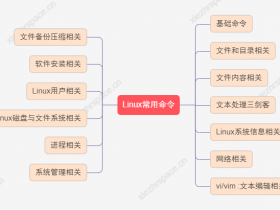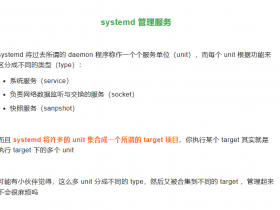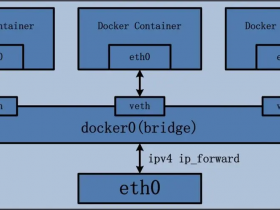- A+
KVM虚拟化
虚拟化介绍
虚拟化:在一台计算机上虚拟出多个逻辑的计算机,而且每个逻辑计算机
它可以是不同操作系统
虚拟化技术:可以扩大硬件容量,单个cpu模拟出多个cpu并行,
允许一个平台上同时运行多个操作系统,应用程序都可以在相互独立
的空间内运行,而且互不影响。
为什么企业使用虚拟化技术
1、节约成本
2、提高效率,物理机我们一般称为宿主机(Host),宿主机上面的虚拟机称为客户机(Guest)。
那么 Host 是如何将自己的硬件资源虚拟化,并提供给 Guest 使用的呢?
这个主要是通过一个叫做 Hypervisor 的程序实现的。
Hypervisor:一种运行在物理服务器硬件与操作系统之间的中间软件层
可允许多个操作系统和应用来共享硬件资源
根据 Hypervisor 的实现方式和所处的位置,虚拟化又分为两种:
完全虚拟化:直接在物理机上部署虚拟化,且不需要修改操作系统内核
半虚拟化:需要修改操作系统内核,使其支持虚拟化驱动来实现虚拟化技术
1、完全虚拟化
Hypervisor 直接安装在物理机上,多个虚拟机在 Hypervisor 上运行。Hypervisor 实现方式一般是一个特殊定制的 Linux 系统。Xen 和 VMWare 的 ESXi 都属于这个类型
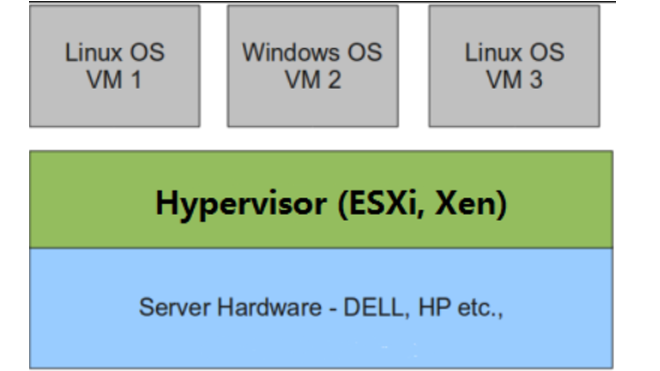
2、半虚拟化
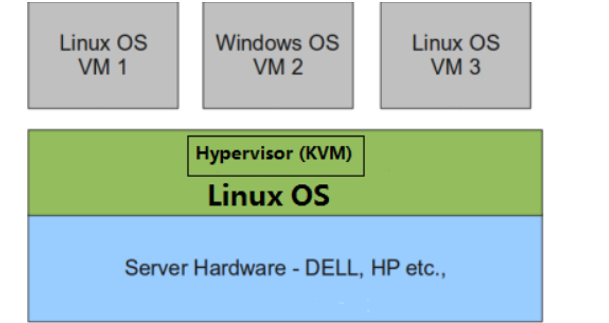
理论上讲:
完全虚拟化一般对硬件虚拟化功能进行了特别优化,性能上比半虚拟化要高;
半虚拟化因为基于普通的操作系统,会比较灵活,比如支持虚拟机嵌套。嵌套意味着可以在KVM虚拟机中再运行KVM。
kvm介绍
kVM 全称是 Kernel-Based Virtual Machine。也就是说 KVM 是基于 Linux 内核实现的。
KVM有一个内核模块叫 kvm.ko,只用于管理虚拟 CPU 和内存。
那 IO 的虚拟化,比如存储和网络设备则是由 Linux 内核与Qemu来实现。
Qemu 是纯软件实现的虚拟化模拟器,几乎可以模拟任何硬件设备,我们最熟悉的就是能够模拟一台能够独立运行操作系统的虚拟机,虚拟机认为自己和硬件打交道,但其实是和 Qemu 模拟出来的硬件打交道,Qemu 将这些指令转译给真正的硬件。
正因为 Qemu 是纯软件实现的,所有的指令都要经 Qemu 过一手,性能非常低,所以,在生产环境中,大多数的做法都是配合 KVM 来完成虚拟化工作,因为 KVM 是硬件辅助的虚拟化技术,主要负责 比较繁琐的 CPU 和内存虚拟化,而 Qemu 则负责 I/O 虚拟化,两者合作各自发挥自身的优势,相得益彰.
作为一个 Hypervisor,KVM 本身只关注虚拟机调度和内存管理这两个方面。IO 外设的任务交给 Linux 内核和 Qemu。
Libvirt 就是 KVM 的管理工具。管理虚拟机和虚拟化功能的软件
其实,Libvirt 除了能管理 KVM 这种 Hypervisor,还能管理 Xen,VirtualBox 等。
Libvirt 包含 3 个东西:后台 daemon 程序 libvirtd、API 库和命令行工具 virsh
1、libvirtd是服务程序,接收和处理 API 请求;
2、API 库使得其他人可以开发基于 Libvirt 的高级工具,比如 virt-manager,这是个图形化的 KVM 管理工具;
3、virsh 是我们经常要用的 KVM 命令行工具
KVM部署(基于CentOS7)
虚拟机的安装步骤可以查看我之前centos8.5的安装,变化倒是不大修改一下对应参数就可以了
环境说明:
系统:CentOS7
ip :192.168.222.140
- CPU虚拟化功能
部署前请确保你的CPU虚拟化功能已开启,分为两种情况:
(1)虚拟机要关机设置CPU虚拟化
(2)物理机要在BIOS里开启CPU虚拟化 - 虚拟机设置(内存:8G 磁盘:80G(自定义可以大一点) 虚拟化功能:开启)
//设置虚拟机内存,添加一块80G的硬盘
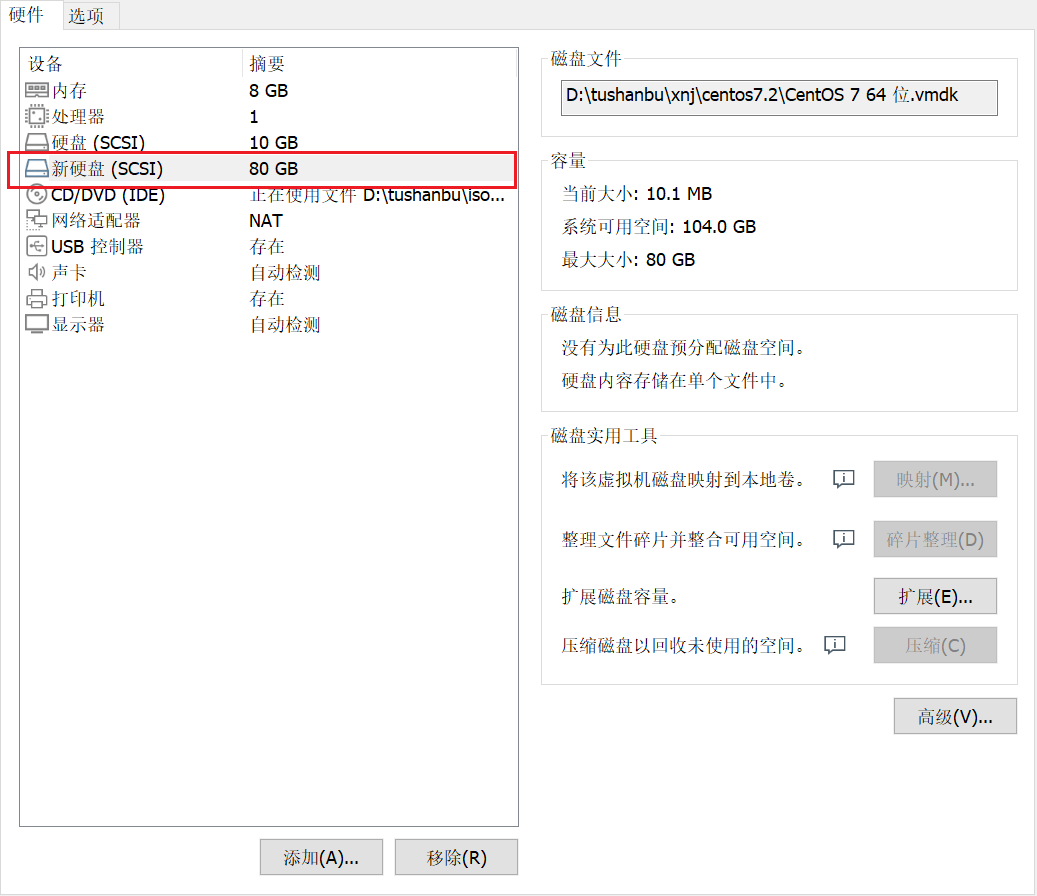
开启虚拟化
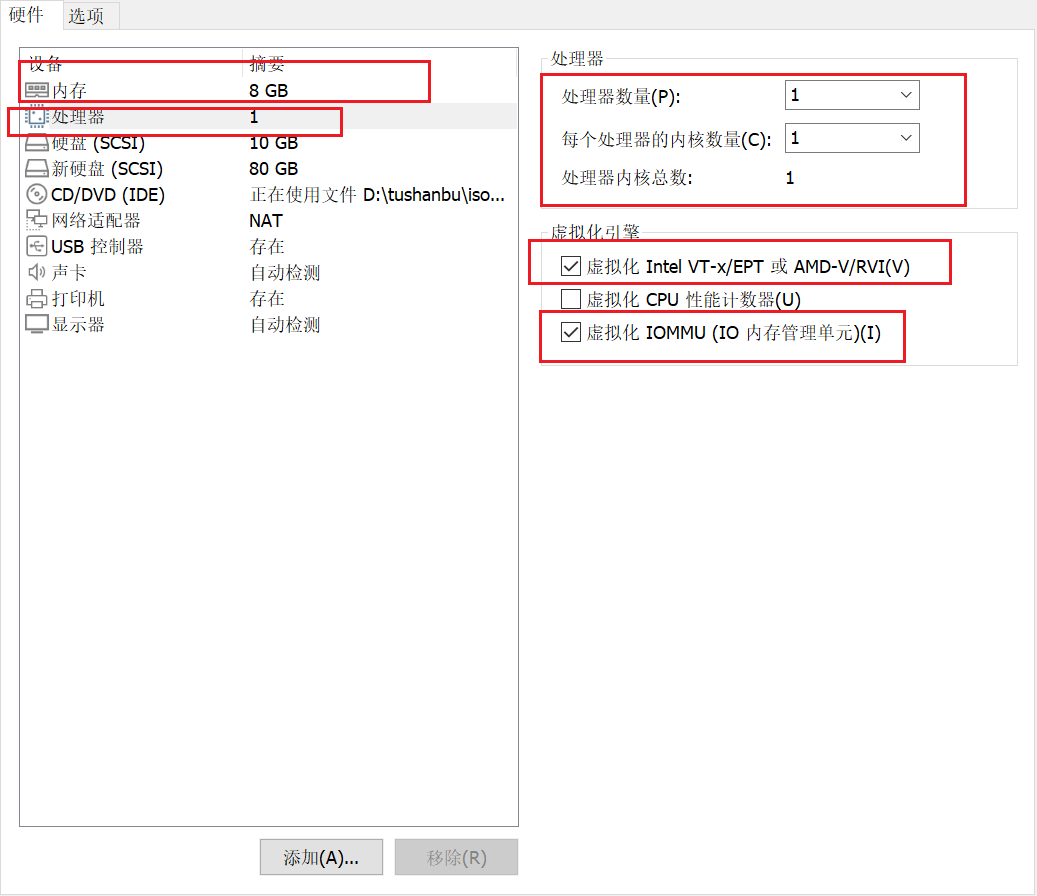
新建分区,将硬盘所有大小都给这个分区
[root@localhost ~]# lsblk //查看一下分区 NAME MAJ:MIN RM SIZE RO TYPE MOUNTPOINT sda 8:0 0 10G 0 disk ├─sda1 8:1 0 1G 0 part /boot └─sda2 8:2 0 9G 0 part ├─centos-root 253:0 0 8G 0 lvm / └─centos-swap 253:1 0 1G 0 lvm [SWAP] sdb 8:16 0 80G 0 disk sr0 11:0 1 4.2G 0 rom [root@localhost ~]# parted /dev/sdb GNU Parted 3.1 使用 /dev/sdb Welcome to GNU Parted! Type 'help' to view a list of commands. (parted) //Tab两下查看 align-check help mktable quit select unit disk_set mklabel name rescue set version disk_toggle mkpart print rm toggle (parted) mklabel 新的磁盘标签类型? //Tab两下查看 aix amiga bsd dvh gpt loop mac msdos pc98 sun 新的磁盘标签类型? msdos (parted) //Tab两下查看 align-check help mktable quit select unit disk_set mklabel name rescue set version disk_toggle mkpart print rm toggle (parted) unit Unit? [compact]? //Tab两下查看 % chs cyl GiB kiB MiB TB B compact GB kB MB s TiB Unit? [compact]? MiB (parted) p Model: VMware, VMware Virtual S (scsi) Disk /dev/sdb: 81920MiB //创建磁盘的大小 Sector size (logical/physical): 512B/512B Partition Table: msdos Disk Flags: Number Start End Size Type File system 标志 (parted) //Tab两下查看 align-check help mktable quit select unit disk_set mklabel name rescue set version disk_toggle mkpart print rm toggle (parted) mkpart 分区类型? primary/主分区/extended/扩展分区? primary 文件系统类型? [ext2]? //Tab两下查看 affs0 amufs apfs2 hfs linux-swap(v0) affs1 amufs0 asfs hfs+ linux-swap(v1) affs2 amufs1 btrfs hfsx nilfs2 affs3 amufs2 ext2 hp-ufs ntfs affs4 amufs3 ext3 jfs reiserfs affs5 amufs4 ext4 linux-swap sun-ufs affs6 amufs5 fat16 linux-swap(new) swsusp affs7 apfs1 fat32 linux-swap(old) xfs 文件系统类型? [ext2]? xfs 起始点? 10MiB 结束点? 81910MiB //比刚刚创建的小10MiB就可以了 (parted) p Model: VMware, VMware Virtual S (scsi) Disk /dev/sdb: 81920MiB Sector size (logical/physical): 512B/512B Partition Table: msdos Disk Flags: Number Start End Size Type File system 标志 1 10.0MiB 81910MiB 81900MiB primary (parted) q 信息: You may need to update /etc/fstab. [root@localhost ~]# udevadm settle 格式化
[root@localhost ~]# lsblk NAME MAJ:MIN RM SIZE RO TYPE MOUNTPOINT sda 8:0 0 10G 0 disk ├─sda1 8:1 0 1G 0 part /boot └─sda2 8:2 0 9G 0 part ├─centos-root 253:0 0 8G 0 lvm / └─centos-swap 253:1 0 1G 0 lvm [SWAP] sdb 8:16 0 80G 0 disk └─sdb1 8:17 0 80G 0 part sr0 11:0 1 4.2G 0 rom [root@localhost ~]# mkfs.xfs /dev/sdb1 meta-data=/dev/sdb1 isize=512 agcount=4, agsize=5241600 blks = sectsz=512 attr=2, projid32bit=1 = crc=1 finobt=0, sparse=0 data = bsize=4096 blocks=20966400, imaxpct=25 = sunit=0 swidth=0 blks naming =version 2 bsize=4096 ascii-ci=0 ftype=1 log =internal log bsize=4096 blocks=10237, version=2 = sectsz=512 sunit=0 blks, lazy-count=1 realtime =none extsz=4096 blocks=0, rtextents=0 [root@localhost ~]# blkid /dev/sdb1 /dev/sdb1: UUID="09888ad8-a1ef-42fb-9c36-937e071bf897" TYPE="xfs" 创建挂载点,并进行永久挂载
[root@localhost ~]# yum -y install vim [root@localhost ~]# mkdir /kvmdata [root@localhost ~]# vim /etc/fstab UUID="09888ad8-a1ef-42fb-9c36-937e071bf897" /kvmdata xfs defaults 0 0 //添加这一行 [root@localhost ~]# mount -a [root@localhost ~]# df -Th 文件系统 类型 容量 已用 可用 已用% 挂载点 /dev/mapper/centos-root xfs 8.0G 1.2G 6.9G 15% / devtmpfs devtmpfs 3.9G 0 3.9G 0% /dev tmpfs tmpfs 3.9G 0 3.9G 0% /dev/shm tmpfs tmpfs 3.9G 8.7M 3.9G 1% /run tmpfs tmpfs 3.9G 0 3.9G 0% /sys/fs/cgroup /dev/sda1 xfs 1014M 143M 872M 15% /boot tmpfs tmpfs 781M 0 781M 0% /run/user/0 /dev/sdb1 xfs 80G 33M 80G 1% /kvmdata KVM安装
关闭防火墙和selinux
[root@localhost ~]# systemctl stop firewalld [root@localhost ~]# vim /etc/selinux/config SELINUX=disabled [root@localhost ~]# setenforce 0 [root@localhost ~]# systemctl disable --now firewalld Removed symlink /etc/systemd/system/multi-user.target.wants/firewalld.service. Removed symlink /etc/systemd/system/dbus-org.fedoraproject.FirewallD1.service. [root@localhost ~]# reboot 部署yum源
可以配置阿里云的网络源
阿里云官网
[root@localhost ~]# cd /etc/yum.repos.d/ [root@localhost yum.repos.d]# ls CentOS-Base.repo CentOS-Debuginfo.repo CentOS-Media.repo CentOS-Vault.repo epel-testing.repo CentOS-CR.repo CentOS-fasttrack.repo CentOS-Sources.repo epel.repo [root@localhost yum.repos.d]# rm -rf * [root@localhost yum.repos.d]# ls [root@localhost yum.repos.d]# curl -o /etc/yum.repos.d/CentOS-Base.repo https://mirrors.aliyun.com/repo/Centos-7.repo % Total % Received % Xferd Average Speed Time Time Time Current Dload Upload Total Spent Left Speed 100 2523 100 2523 0 0 9299 0 --:--:-- --:--:-- --:--:-- 9309 [root@localhost yum.repos.d]# sed -i -e '/mirrors.cloud.aliyuncs.com/d' -e '/mirrors.aliyuncs.com/d' /etc/yum.repos.d/CentOS-Base.repo [root@localhost yum.repos.d]# ls CentOS-Base.repo 安装所需软件包
[root@localhost yum.repos.d]# cd [root@localhost ~]# yum -y install epel-release wget net-tools unzip zip gcc gcc-c++ 验证cpu是否支持kvm,vmx是intel的 svm是AMD的
[root@localhost ~]# egrep -o 'vmx|svm' /proc/cpuinfo vmx 安装kvm
[root@localhost ~]# yum -y install qemu-kvm > qemu-kvm-tools > qemu-img > virt-manager > libvirt > libvirt-python > libvirt-client > virt-install > virt-viewer > bridge-utils > libguestfs-tools 配置网络,因为虚拟机中的网络,我们一般是都和公司服务器处在同一网段的,所以我们需要把kvm的网卡配置成桥接模式
[root@localhost ~]# cd /etc/sysconfig/network-scripts/ [root@localhost network-scripts]# ls ifcfg-ens33 ifdown-ipv6 ifdown-TeamPort ifup-ippp ifup-routes network-functions ifcfg-lo ifdown-isdn ifdown-tunnel ifup-ipv6 ifup-sit network-functions-ipv6 ifdown ifdown-post ifup ifup-isdn ifup-Team ifdown-bnep ifdown-ppp ifup-aliases ifup-plip ifup-TeamPort ifdown-eth ifdown-routes ifup-bnep ifup-plusb ifup-tunnel ifdown-ib ifdown-sit ifup-eth ifup-post ifup-wireless ifdown-ippp ifdown-Team ifup-ib ifup-ppp init.ipv6-global [root@localhost network-scripts]# cp ifcfg-ens33 ifcfg-br0 [root@localhost network-scripts]# vim ifcfg-br0 [root@localhost network-scripts]# cat ifcfg-br0 TYPE=bridge BOOTPROTO=none NAME=br0 DEVICE=br0 ONBOOT=yes IPADDR=192.168.222.140 PREFIX=24 GATEWAY=192.168.222.2 DNS1=192.168.222.2 [root@localhost network-scripts]# vim ifcfg-ens33 [root@localhost network-scripts]# cat ifcfg-ens33 TYPE=Ethernet BOOTPROTO=none NAME=ens33 DEVICE=ens33 ONBOOT=yes BRIDGE=br0 [root@localhost network-scripts]# systemctl restart NetworkManager [root@localhost network-scripts]# ifdown ens33;ifup ens33 成功断开设备 'ens33'。 连接已成功激活(D-Bus 活动路径:/org/freedesktop/NetworkManager/ActiveConnection/3) [root@localhost network-scripts]# cd [root@localhost ~]# ifconfig br0: flags=4163<UP,BROADCAST,RUNNING,MULTICAST> mtu 1500 inet 192.168.222.140 netmask 255.255.255.0 broadcast 192.168.222.255 inet6 fe80::1c12:5bff:fea2:ba71 prefixlen 64 scopeid 0x20<link> ether 00:0c:29:5a:f0:0d txqueuelen 1000 (Ethernet) RX packets 494 bytes 34964 (34.1 KiB) RX errors 0 dropped 0 overruns 0 frame 0 TX packets 813 bytes 143186 (139.8 KiB) TX errors 0 dropped 0 overruns 0 carrier 0 collisions 0 ens33: flags=4163<UP,BROADCAST,RUNNING,MULTICAST> mtu 1500 ether 00:0c:29:5a:f0:0d txqueuelen 1000 (Ethernet) RX packets 201496 bytes 194698973 (185.6 MiB) RX errors 0 dropped 0 overruns 0 frame 0 TX packets 108153 bytes 10993998 (10.4 MiB) TX errors 0 dropped 0 overruns 0 carrier 0 collisions 0 lo: flags=73<UP,LOOPBACK,RUNNING> mtu 65536 inet 127.0.0.1 netmask 255.0.0.0 inet6 ::1 prefixlen 128 scopeid 0x10<host> loop txqueuelen 1 (Local Loopback) RX packets 0 bytes 0 (0.0 B) RX errors 0 dropped 0 overruns 0 frame 0 TX packets 0 bytes 0 (0.0 B) TX errors 0 dropped 0 overruns 0 carrier 0 collisions 0 重启libvirtd服务,并设置开机自启
[root@localhost ~]# systemctl enable --now libvirtd [root@localhost ~]# systemctl status libvirtd ● libvirtd.service - Virtualization daemon Loaded: loaded (/usr/lib/systemd/system/libvirtd.service; enabled; vendor preset: enabled) Active: active (running) since 三 2022-10-05 02:57:06 CST; 10s ago Docs: man:libvirtd(8) https://libvirt.org Main PID: 106910 (libvirtd) Tasks: 19 (limit: 32768) CGroup: /system.slice/libvirtd.service ├─106910 /usr/sbin/libvirtd ├─107058 /usr/sbin/dnsmasq --conf-file=/var/lib/libvirt/dnsmasq/default.conf --leasefil... └─107060 /usr/sbin/dnsmasq --conf-file=/var/lib/libvirt/dnsmasq/default.conf --leasefil... 10月 05 02:57:07 localhost.example.com dnsmasq[107052]: listening on virbr0(#4): 192.168.122.1 10月 05 02:57:07 localhost.example.com dnsmasq[107058]: started, version 2.76 cachesize 150 10月 05 02:57:07 localhost.example.com dnsmasq[107058]: compile time options: IPv6 GNU-getopt D...fy 10月 05 02:57:07 localhost.example.com dnsmasq-dhcp[107058]: DHCP, IP range 192.168.122.2 -- 192...h 10月 05 02:57:07 localhost.example.com dnsmasq-dhcp[107058]: DHCP, sockets bound exclusively to ...0 10月 05 02:57:07 localhost.example.com dnsmasq[107058]: reading /etc/resolv.conf 10月 05 02:57:07 localhost.example.com dnsmasq[107058]: using nameserver 192.168.222.2#53 10月 05 02:57:07 localhost.example.com dnsmasq[107058]: read /etc/hosts - 2 addresses 10月 05 02:57:07 localhost.example.com dnsmasq[107058]: read /var/lib/libvirt/dnsmasq/default.a...es 10月 05 02:57:07 localhost.example.com dnsmasq-dhcp[107058]: read /var/lib/libvirt/dnsmasq/defau...e Hint: Some lines were ellipsized, use -l to show in full. 查看kvm模块是否加载
[root@localhost ~]# lsmod |grep kvm kvm_intel 170086 0 kvm 566340 1 kvm_intel irqbypass 13503 1 kvm 验证安装结果
[root@localhost ~]# virsh -c qemu:///system list Id 名称 状态 ---------------------------------------------------- [root@localhost ~]# virsh --version 4.5.0 [root@localhost ~]# virt-install --version 1.5.0 将qemu-kvm这个命令做一个软链接到/usr/bin/qemu-kvm
[root@localhost ~]# ln -s /usr/libexec/qemu-kvm /usr/bin/qemu-kvm [root@localhost ~]# ll /usr/bin/qemu-kvm lrwxrwxrwx 1 root root 21 10月 5 03:01 /usr/bin/qemu-kvm -> /usr/libexec/qemu-kvm 查看网桥信息
[root@localhost ~]# brctl show bridge name bridge id STP enabled interfaces br0 8000.000c295af00d no ens33 virbr0 8000.525400e562ac yes virbr0-nic KVM管理界面安装
Kvm的web界面是由webvirtmgr程序提供的
安装依赖包
[root@localhost ~]# yum -y install git python-pip libvirt-python libxml2-python python-websockify supervisor nginx python-devel ..... 已安装: git.x86_64 0:1.8.3.1-23.el7_8 nginx.x86_64 1:1.20.1-9.el7 python-devel.x86_64 0:2.7.5-92.el7_9 python-websockify.noarch 0:0.6.0-2.el7 python2-pip.noarch 0:8.1.2-14.el7 supervisor.noarch 0:3.4.0-1.el7 作为依赖被安装: centos-indexhtml.noarch 0:7-9.el7.centos nginx-filesystem.noarch 1:1.20.1-9.el7 openssl11-libs.x86_64 1:1.1.1k-4.el7 perl-Error.noarch 1:0.17020-2.el7 perl-Git.noarch 0:1.8.3.1-23.el7_8 perl-TermReadKey.x86_64 0:2.30-20.el7 python-meld3.x86_64 0:0.6.10-1.el7 python-rpm-macros.noarch 0:3-34.el7 python-setuptools.noarch 0:0.9.8-7.el7 python-srpm-macros.noarch 0:3-34.el7 python2-rpm-macros.noarch 0:3-34.el7 rsync.x86_64 0:3.1.2-11.el7_9 作为依赖被升级: python.x86_64 0:2.7.5-92.el7_9 python-libs.x86_64 0:2.7.5-92.el7_9 完毕! 可以提前做一个映射,防止访问不了github
[root@localhost ~]# vim /etc/hosts [root@localhost ~]# cat /etc/hosts 127.0.0.1 localhost localhost.localdomain localhost4 localhost4.localdomain4 ::1 localhost localhost.localdomain localhost6 localhost6.localdomain6 20.205.243.166 github.com //添加 从github上下载webvirtmgr代码
[root@localhost ~]# cd /usr/local/src/ [root@localhost src]# git clone http://github.com/retspen/webvirtmgr.git 正克隆到 'webvirtmgr'... remote: Enumerating objects: 5614, done. remote: Total 5614 (delta 0), reused 0 (delta 0), pack-reused 5614 接收对象中: 100% (5614/5614), 2.97 MiB | 689.00 KiB/s, done. 处理 delta 中: 100% (3606/3606), done. 安装webvirtmgr
[root@localhost src]# ls webvirtmgr [root@localhost src]# cd webvirtmgr/ [root@localhost webvirtmgr]# pip install -r requirements.txt Collecting django==1.5.5 (from -r requirements.txt (line 1)) Downloading https://files.pythonhosted.org/packages/38/49/93511c5d3367b6b21fc2995a0e53399721afc15e4cd6eb57be879ae13ad4/Django-1.5.5.tar.gz (8.1MB) 100% |████████████████████████████████| 8.1MB 42kB/s Collecting gunicorn==19.5.0 (from -r requirements.txt (line 2)) Downloading https://files.pythonhosted.org/packages/f9/4e/f4076a1a57fc1e75edc0828db365cfa9005f9f6b4a51b489ae39a91eb4be/gunicorn-19.5.0-py2.py3-none-any.whl (113kB) 100% |████████████████████████████████| 122kB 104kB/s Collecting lockfile>=0.9 (from -r requirements.txt (line 5)) Downloading https://files.pythonhosted.org/packages/c8/22/9460e311f340cb62d26a38c419b1381b8593b0bb6b5d1f056938b086d362/lockfile-0.12.2-py2.py3-none-any.whl Installing collected packages: django, gunicorn, lockfile Running setup.py install for django ... done Successfully installed django-1.5.5 gunicorn-19.5.0 lockfile-0.12.2 You are using pip version 8.1.2, however version 22.2.2 is available. You should consider upgrading via the 'pip install --upgrade pip' command. 检查sqlite3是否安装
[root@localhost ~]# python Python 2.7.5 (default, Jun 28 2022, 15:30:04) [GCC 4.8.5 20150623 (Red Hat 4.8.5-44)] on linux2 Type "help", "copyright", "credits" or "license" for more information. >>> import sqlite3 >>> exit() 初始化账号信息
[root@localhost ~]# cd /usr/local/src/webvirtmgr/ [root@localhost webvirtmgr]# python manage.py syncdb WARNING:root:No local_settings file found. Creating tables ... Creating table auth_permission Creating table auth_group_permissions Creating table auth_group Creating table auth_user_groups Creating table auth_user_user_permissions Creating table auth_user Creating table django_content_type Creating table django_session Creating table django_site Creating table servers_compute Creating table instance_instance Creating table create_flavor You just installed Django's auth system, which means you don't have any superusers defined. Would you like to create one now? (yes/no): yes //是否创建超级管理员账号 Username (leave blank to use 'root'): //指定超级管理员账号用户名,默认留空为root Email address: [email protected] //设置超级管理员邮箱 Password: //设置超级管理员密码 Password (again): //再次输入确认超级管理员密码 Superuser created successfully. Installing custom SQL ... Installing indexes ... Installed 6 object(s) from 1 fixture(s) 拷贝web网页到指定目录
root@localhost webvirtmgr]# mkdir /var/www [root@localhost webvirtmgr]# cp -r /usr/local/src/webvirtmgr/ /var/www/ [root@localhost webvirtmgr]# chown -R nginx.nginx /var/www/webvirtmgr/ 生成一对公钥与私钥,由于这里webvirtmgr和kvm服务部署在同一台主机中,所以这里本地信任。如果kvm部署在其他机器上的时候,那么就需要把公钥发送到kvm主机中
[root@localhost webvirtmgr]# ssh-keygen Generating public/private rsa key pair. Enter file in which to save the key (/root/.ssh/id_rsa): //直接回车 Created directory '/root/.ssh'. Enter passphrase (empty for no passphrase): /直接回车 Enter same passphrase again: /直接回车 Your identification has been saved in /root/.ssh/id_rsa. Your public key has been saved in /root/.ssh/id_rsa.pub. The key fingerprint is: SHA256:GM4Wtczgi6KVA8VnhunqFApm06RP221yf9hwbhE63Ig [email protected] The key's randomart image is: +---[RSA 2048]----+ | ..o . . | | .+.+. = . | |..++ + + | |.B.+ + = . | |=.X + B S + . | |o+ = + E * + | |+ + . B . | | . o = | | o | +----[SHA256]-----+ [root@localhost webvirtmgr]# ssh-copy-id -i ~/.ssh/id_rsa.pub [email protected] /usr/bin/ssh-copy-id: INFO: Source of key(s) to be installed: "/root/.ssh/id_rsa.pub" The authenticity of host '192.168.222.140 (192.168.222.140)' can't be established. ECDSA key fingerprint is SHA256:FkmNy5vPRVhOZGwZpvDsgPmo4WjilEinC9gpRbRiZQQ. ECDSA key fingerprint is MD5:57:cc:00:bc:17:10:5d:1c:ed:ac:19:bf:7b:66:a3:62. Are you sure you want to continue connecting (yes/no)? yes /usr/bin/ssh-copy-id: INFO: attempting to log in with the new key(s), to filter out any that are already installed /usr/bin/ssh-copy-id: INFO: 1 key(s) remain to be installed -- if you are prompted now it is to install the new keys [email protected]'s password: Number of key(s) added: 1 Now try logging into the machine, with: "ssh '[email protected]'" and check to make sure that only the key(s) you wanted were added. 配置端口转发
可以使用ss -antl查看端口情况
[root@localhost webvirtmgr]# ssh 192.168.222.140 -L localhost:8000:localhost:8000 -L localhost:6080:localhost:60 Last login: Wed Oct 5 17:08:52 2022 from 192.168.222.1 [root@localhost ~]# ss -antl State Recv-Q Send-Q Local Address:Port Peer Address:Port LISTEN 0 5 192.168.122.1:53 *:* LISTEN 0 128 *:22 *:* LISTEN 0 100 127.0.0.1:25 *:* LISTEN 0 128 127.0.0.1:6080 *:* LISTEN 0 128 127.0.0.1:8000 *:* LISTEN 0 128 :::22 :::* LISTEN 0 100 ::1:25 :::* LISTEN 0 128 ::1:6080 :::* LISTEN 0 128 ::1:8000 :::* 配置nginx
[root@localhost ~]# cp /etc/nginx/nginx.conf /etc/nginx/nginx.conf.bak [root@localhost ~]# vim /etc/nginx/nginx.conf //在server参数中进行修改 删除listen [::]:80;行 参数server_name行改成server_name localhost; 删除root /usr/share/nginx/html;行 在include /etc/nginx/default.d/*.conf;行下添加 location / { root html; index index.html index.htm; } 配置nginx虚拟主机
[root@localhost ~]# vim /etc/nginx/conf.d/webvirtmgr.conf [root@localhost ~]# cat /etc/nginx/conf.d/webvirtmgr.conf server { listen 80 default_server; server_name $hostname; #access_log /var/log/nginx/webvirtmgr_access_log; location /static/ { root /var/www/webvirtmgr/webvirtmgr; expires max; } location / { proxy_pass http://127.0.0.1:8000; proxy_set_header X-Real-IP $remote_addr; proxy_set_header X-Forwarded-for $proxy_add_x_forwarded_for; proxy_set_header Host $host:$server_port; proxy_set_header X-Forwarded-Proto $remote_addr; proxy_connect_timeout 600; proxy_read_timeout 600; proxy_send_timeout 600; client_max_body_size 1024M; } } 确保bind绑定本机的8000端口
[root@localhost ~]# vim /var/www/webvirtmgr/conf/gunicorn.conf.py bind = '127.0.0.1:8000' //默认 backlog = 2048 //默认 [root@localhost ~]# grep bind /var/www/webvirtmgr/conf/gunicorn.conf.py # bind - The socket to bind. bind = '127.0.0.1:8000' //确保此处绑定的是本机的8000端口,这个在nginx配置中定义了,被代理的端口 重启nginx服务设置开机自启,查看端口是否开启
[root@localhost ~]# systemctl enable --now nginx Created symlink from /etc/systemd/system/multi-user.target.wants/nginx.service to /usr/lib/systemd/system/nginx.service. [root@localhost ~]# ss -antl State Recv-Q Send-Q Local Address:Port Peer Address:Port LISTEN 0 128 *:80 *:* LISTEN 0 5 192.168.122.1:53 *:* LISTEN 0 128 *:22 *:* LISTEN 0 100 127.0.0.1:25 *:* LISTEN 0 128 127.0.0.1:6080 *:* LISTEN 0 128 127.0.0.1:8000 *:* LISTEN 0 128 :::22 :::* LISTEN 0 100 ::1:25 :::* LISTEN 0 128 ::1:6080 :::* LISTEN 0 128 ::1:8000 :::* 设置supervisor
[root@localhost ~]# vim /etc/supervisord.conf //在文件最后添加如下信息 #这里command是一行 [program:webvirtmgr] command=/usr/bin/python2 /var/www/webvirtmgr/manage.py run_gunicorn -c /var/www/webvirtmgr/conf/gunicorn.conf.py directory=/var/www/webvirtmgr autostart=true autorestart=true logfile=/var/log/supervisor/webvirtmgr.log log_stderr=true user=nginx [program:webvirtmgr-console] command=/usr/bin/python2 /var/www/webvirtmgr/console/webvirtmgr-console directory=/var/www/webvirtmgr autostart=true autorestart=true stdout_logfile=/var/log/supervisor/webvirtmgr-console.log redirect_stderr=true user=nginx 启动supervisor并设置开机自启
[root@localhost ~]# systemctl enable --now supervisord.service Created symlink from /etc/systemd/system/multi-user.target.wants/supervisord.service to /usr/lib/systemd/system/supervisord.service. 配置nginx用户
[root@localhost ~]# su - nginx -s /bin/bash -bash-4.2$ ssh-keygen Generating public/private rsa key pair. Enter file in which to save the key (/var/lib/nginx/.ssh/id_rsa): Created directory '/var/lib/nginx/.ssh'. Enter passphrase (empty for no passphrase): Enter same passphrase again: Your identification has been saved in /var/lib/nginx/.ssh/id_rsa. Your public key has been saved in /var/lib/nginx/.ssh/id_rsa.pub. The key fingerprint is: SHA256:U+al0qUqjCY2+jySrqJYJ/+mc9fkaVtgPovqsa9+qCE [email protected] The key's randomart image is: +---[RSA 2048]----+ | | | | | o o | | = = | | S B | | o *.. | | .E = +..+o.. | |==.O..++o.=+ | |X+o.+XB*o.o. | +----[SHA256]-----+ -bash-4.2$ touch ~/.ssh/config -bash-4.2$ echo -e "StrictHostKeyChecking=nonUserKnownHostsFile=/dev/null" >> ~/.ssh/config -bash-4.2$ chmod 0600 ~/.ssh/config -bash-4.2$ ssh-copy-id -i ~/.ssh/id_rsa.pub [email protected] /bin/ssh-copy-id: INFO: Source of key(s) to be installed: "/var/lib/nginx/.ssh/id_rsa.pub" /bin/ssh-copy-id: INFO: attempting to log in with the new key(s), to filter out any that are already installed /bin/ssh-copy-id: INFO: 1 key(s) remain to be installed -- if you are prompted now it is to install the new keys Warning: Permanently added '192.168.222.140' (ECDSA) to the list of known hosts. [email protected]'s password: Number of key(s) added: 1 Now try logging into the machine, with: "ssh '[email protected]'" and check to make sure that only the key(s) you wanted were added. -bash-4.2$ ssh [email protected] Warning: Permanently added '192.168.222.140' (ECDSA) to the list of known hosts. Last login: Wed Oct 5 17:34:44 2022 from 192.168.222.140 [root@localhost ~]# exit logout Connection to 192.168.222.140 closed. -bash-4.2$ exit logout [root@localhost ~]# root@localhost ~]# vim /etc/polkit-1/localauthority/50-local.d/50-libvirt-remote-access.pkla [root@localhost ~]# cat /etc/polkit-1/localauthority/50-local.d/50-libvirt-remote-access.pkla bvirt SSH access] Identity=unix-user:root Action=org.libvirt.unix.manage ResultAny=yes ResultInactive=yes ResultActive=yes [root@localhost ~]# chown -R root.root /etc/polkit-1/localauthority/50-local.d/50-libvirt-remote-access.pkla [root@localhost ~]# systemctl enable --now nginx [root@localhost ~]# systemctl enable --now libvirtd KVM web界面管理
修改nginx配置文件
[root@localhost ~]# vim /etc/nginx/nginx.conf user nginx; worker_processes auto; error_log /var/log/nginx/error.log; pid /run/nginx.pid; worker_rlimit_nofile 655350; //添加此行 对系统参数进行设置
[root@localhost ~]# vim /etc/security/limits.conf //在文件最末尾写入 * soft nofile 655350 * hard nofile 655350 重启服务,重读文件
[root@localhost ~]# sysctl -p [root@localhost ~]# systemctl enable --now nginx 安装novnc,并通过novnc_server启动一个vnc
[root@localhost ~]# yum -y install novnc [root@localhost ~]# chmod +x /etc/rc.d/rc.local [root@localhost ~]# vim /etc/rc.d/rc.local //在最末尾加入如下行 nohup novnc_server 192.168.222.140:5920 & [root@localhost ~]# . /etc/rc.d/rc.local [root@localhost ~]# nohup: 忽略输入并把输出追加到"nohup.out" 这里会一直停在这里 使用浏览器访问
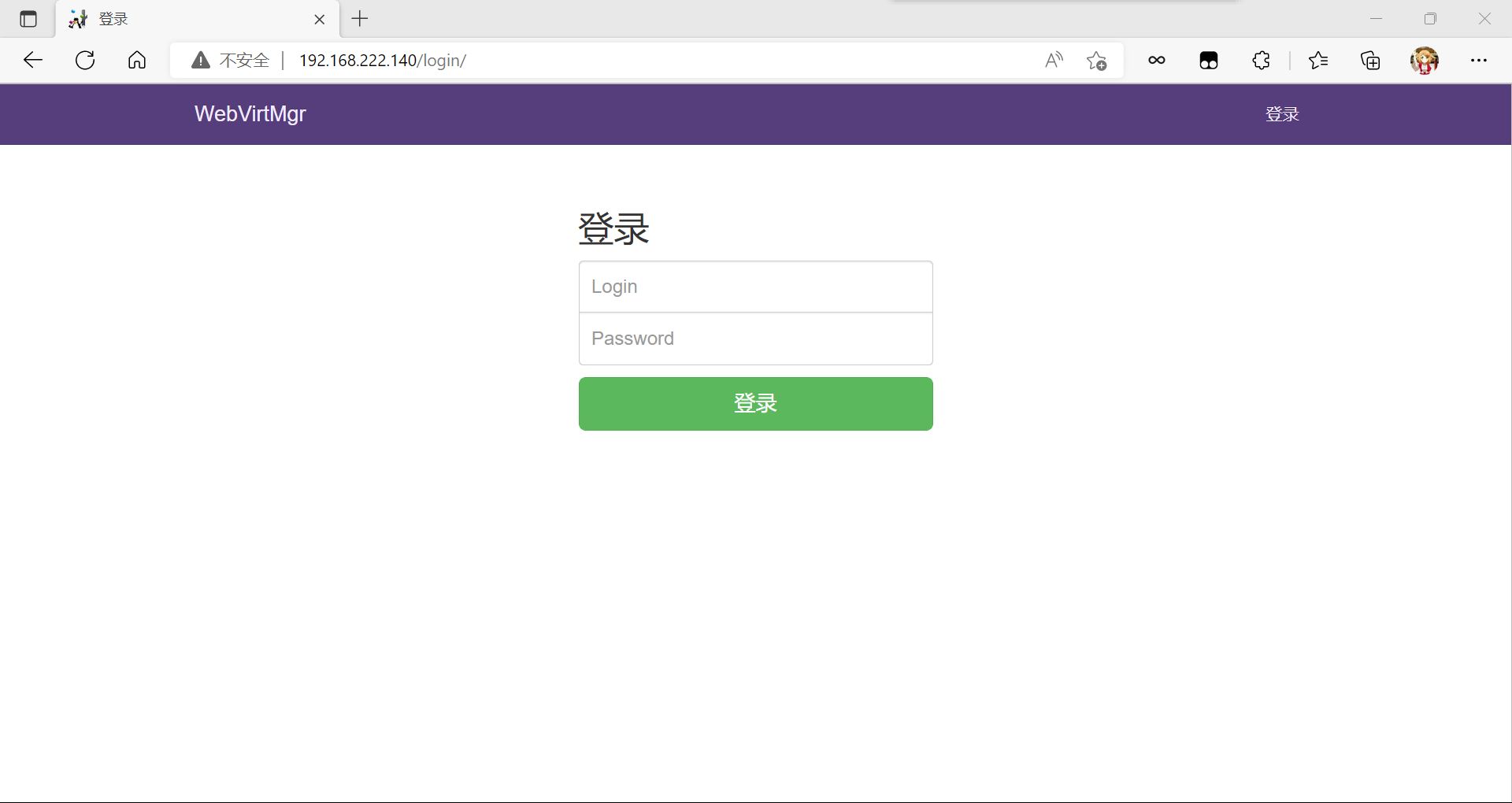
登录用户是之前设置的默认root,密码也是之前设置的
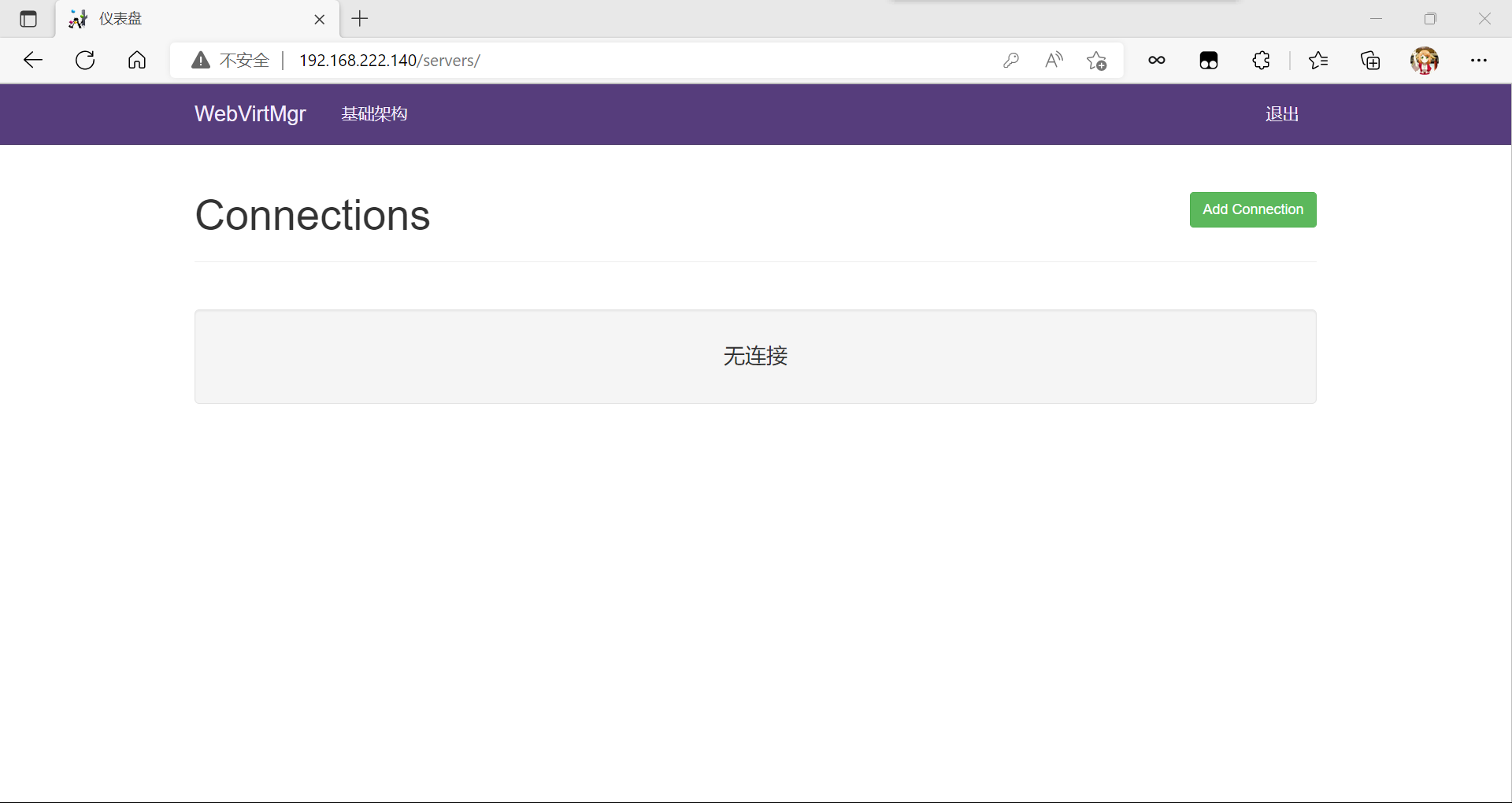
添加连接
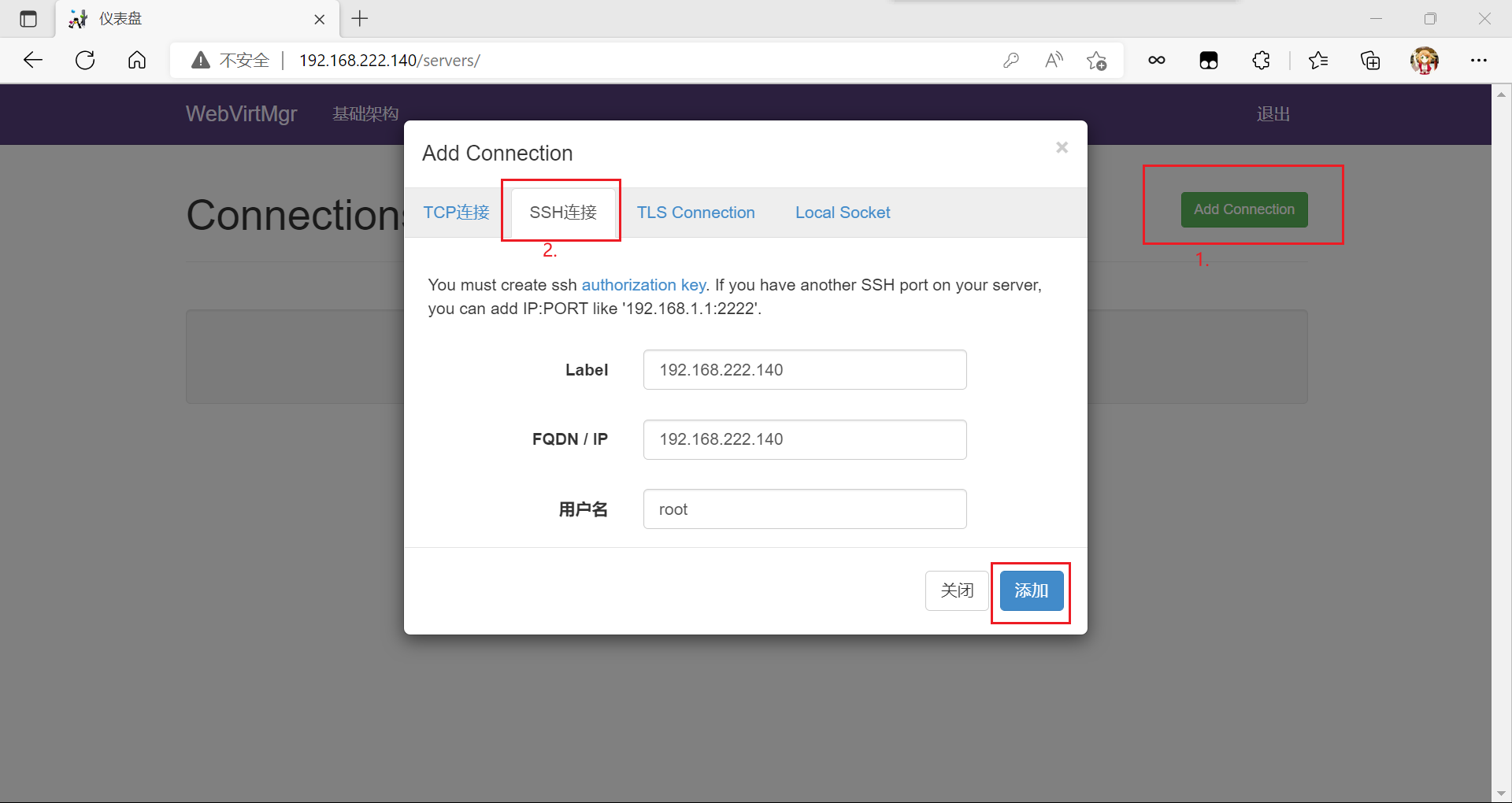
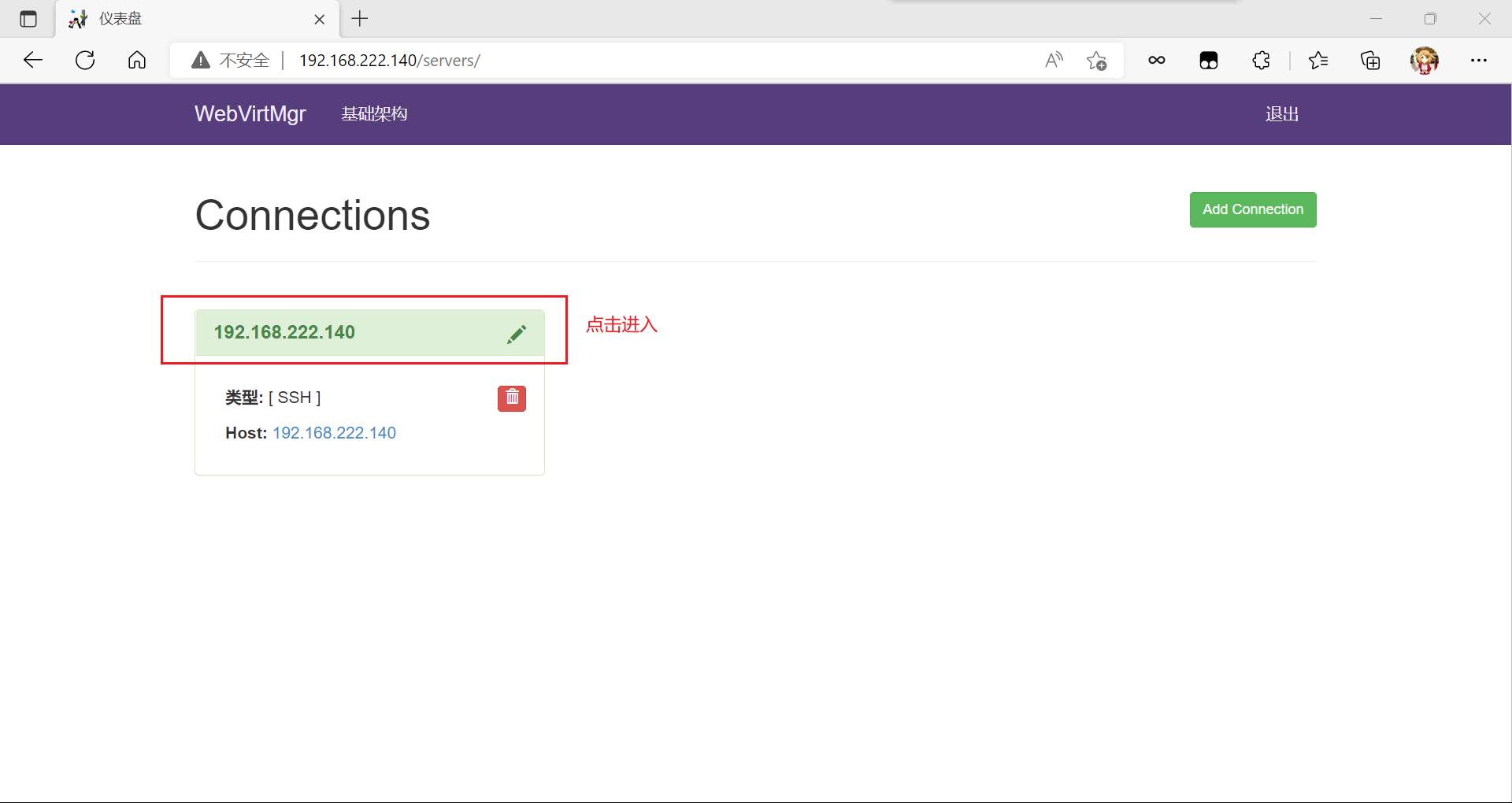
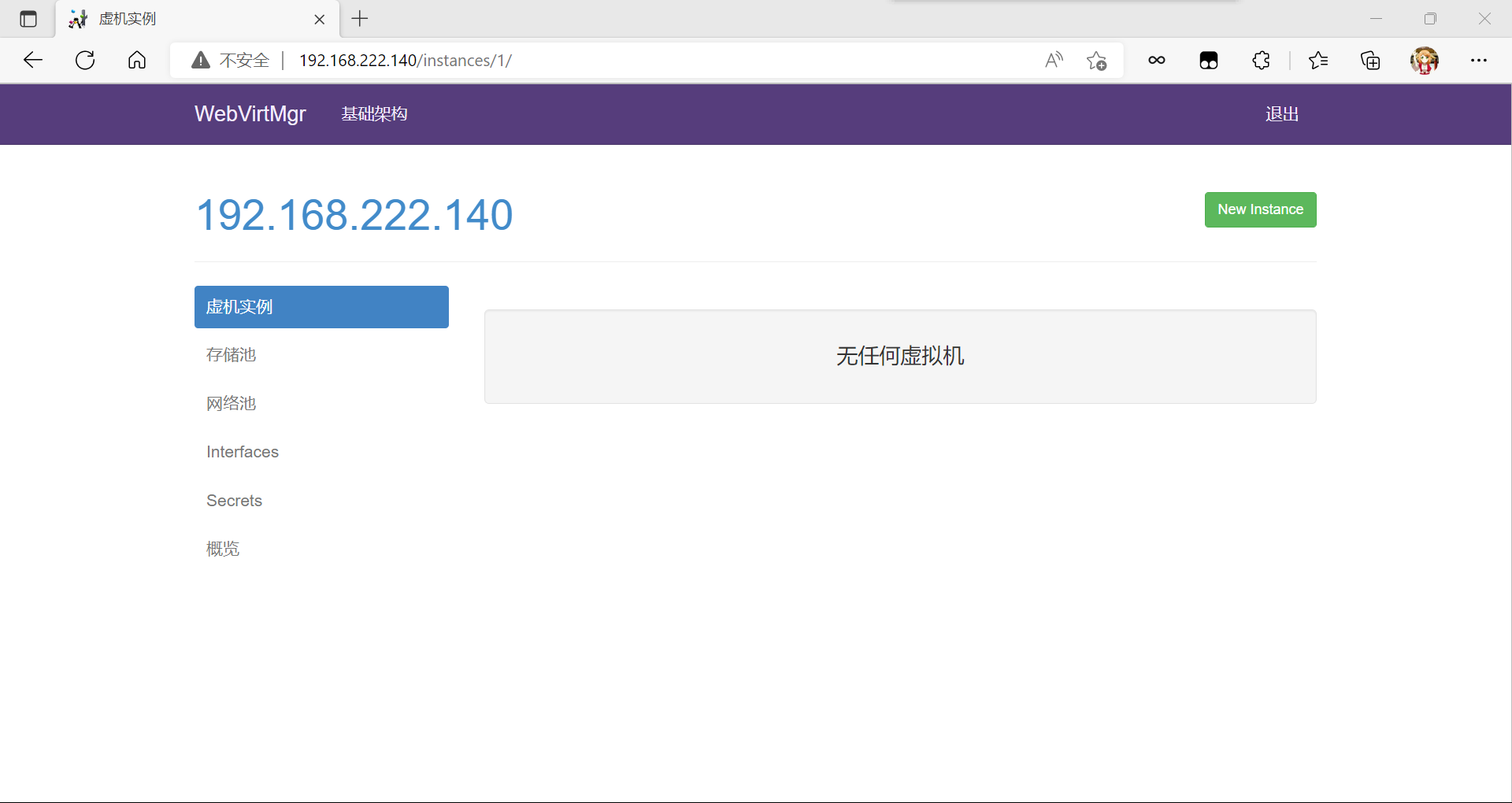
创建虚拟机
1、新建存储
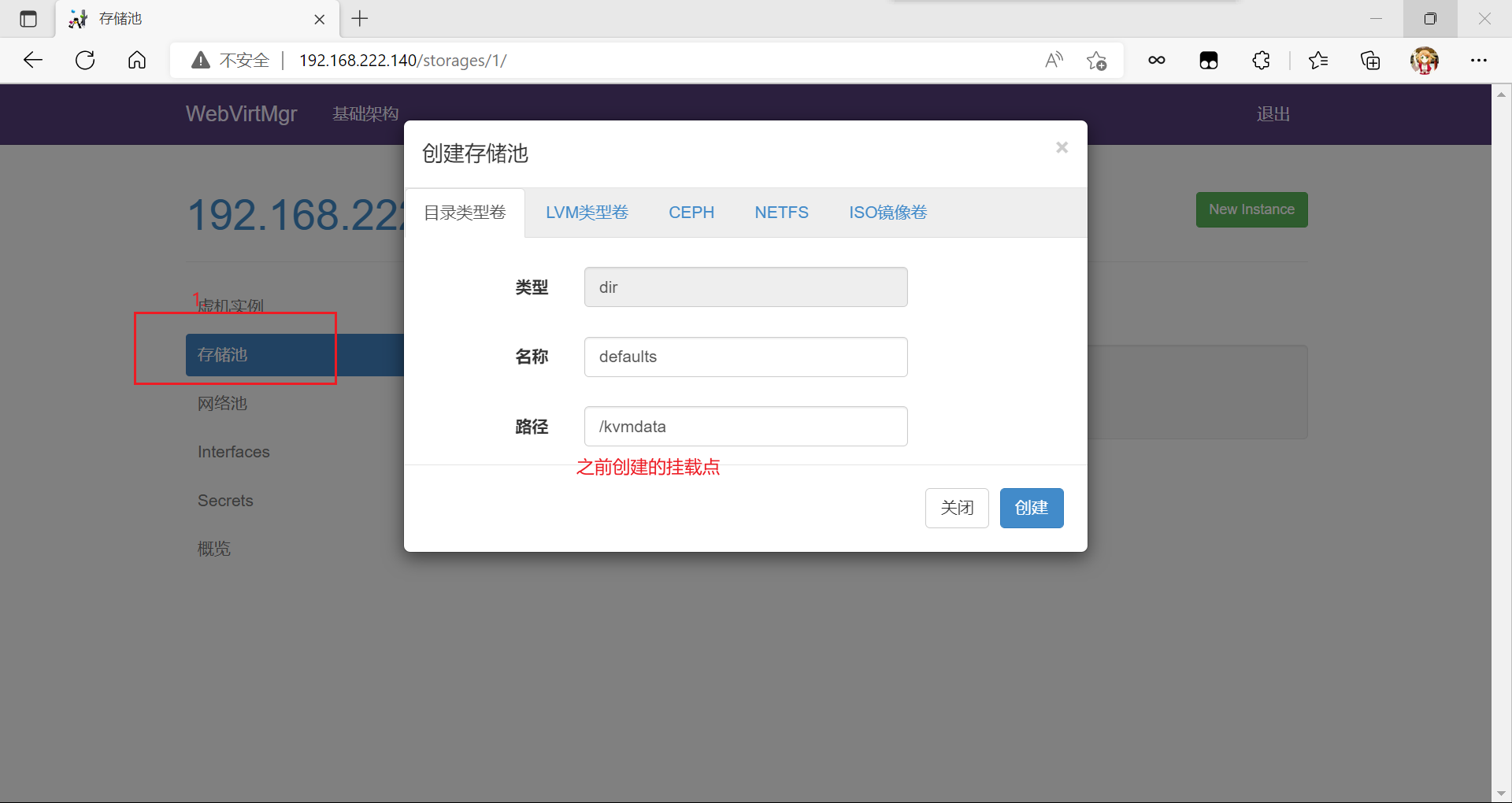
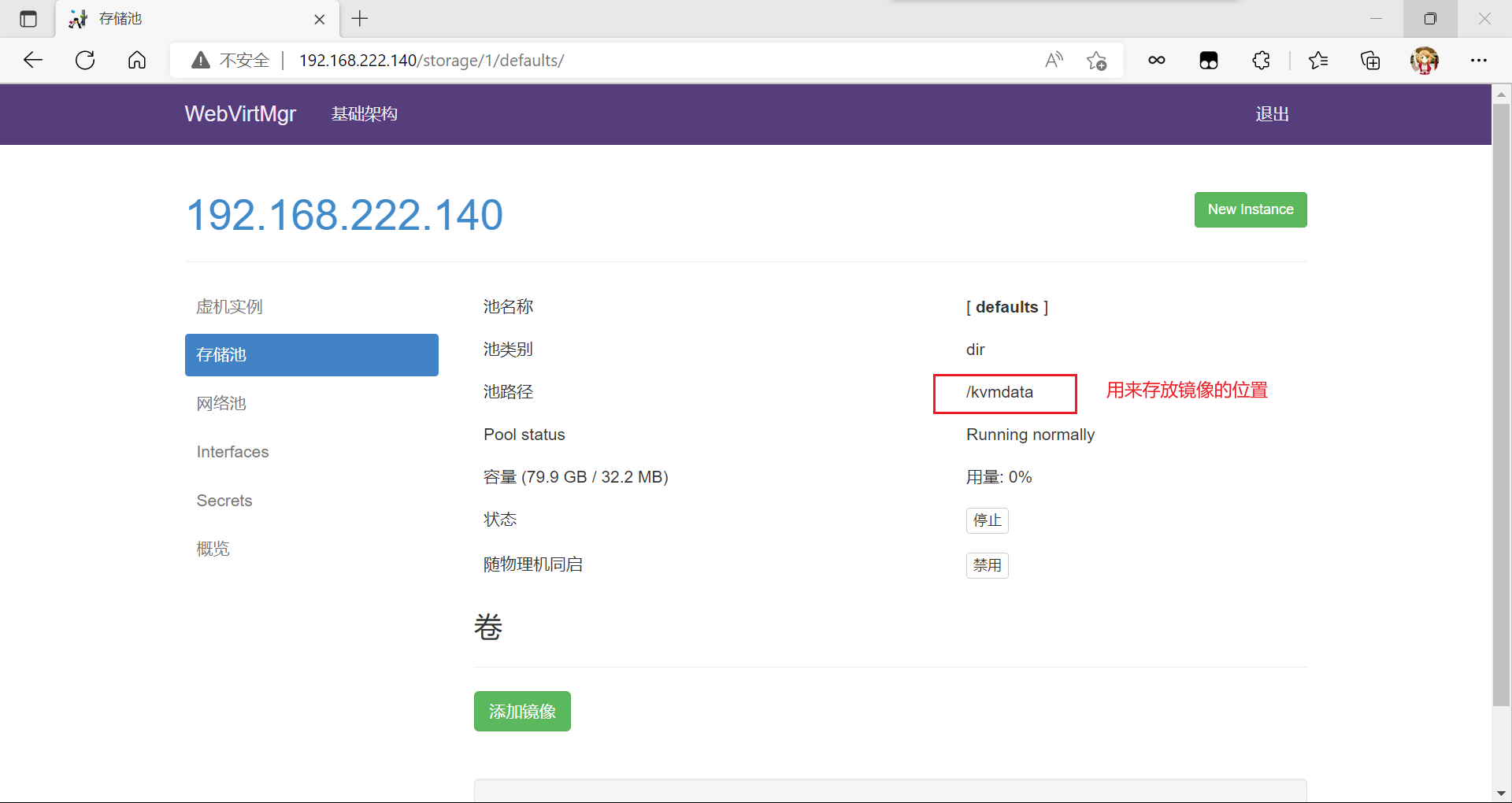
2、上传镜像,使用FinalShell,xftp或者xshell,再或者其他工具,将镜像文件上传到服务器的/kvmdata目录下存放
再开一个终端: [root@localhost ~]# cd /kvmdata/ [root@localhost kvmdata]# ls CentOS-7.4-x86_64-DVD-1708.iso 刷新一下网页界面
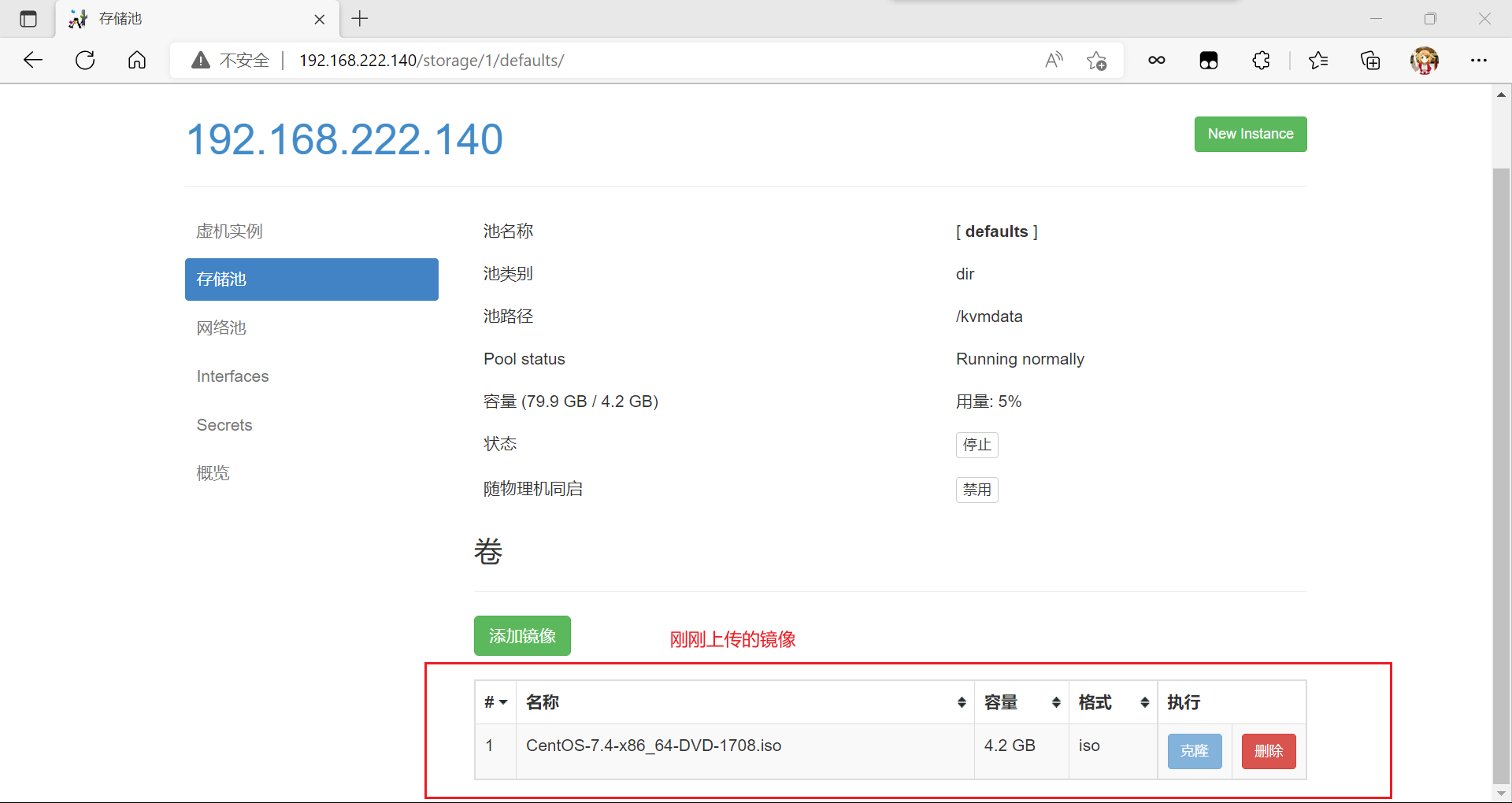
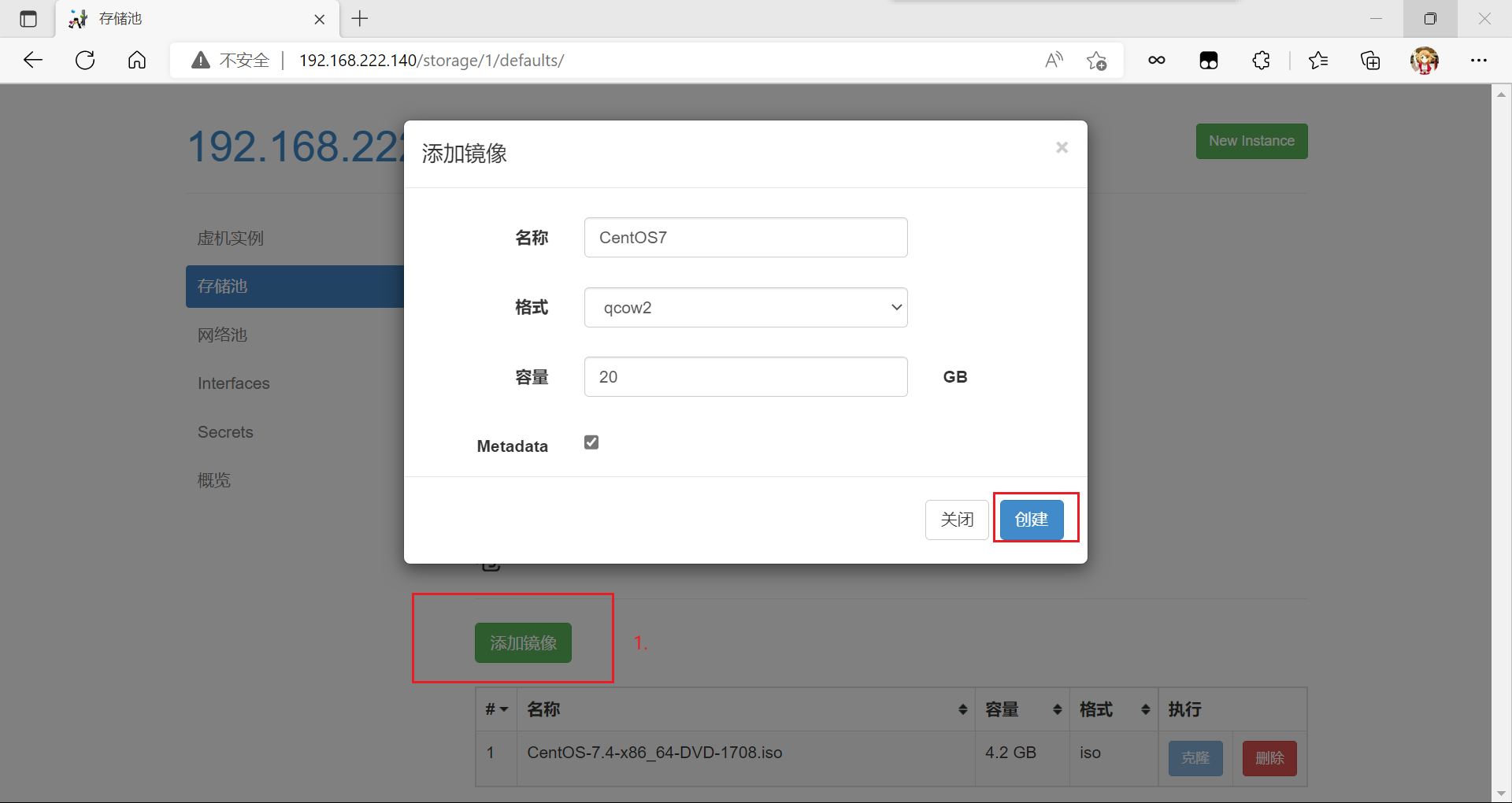
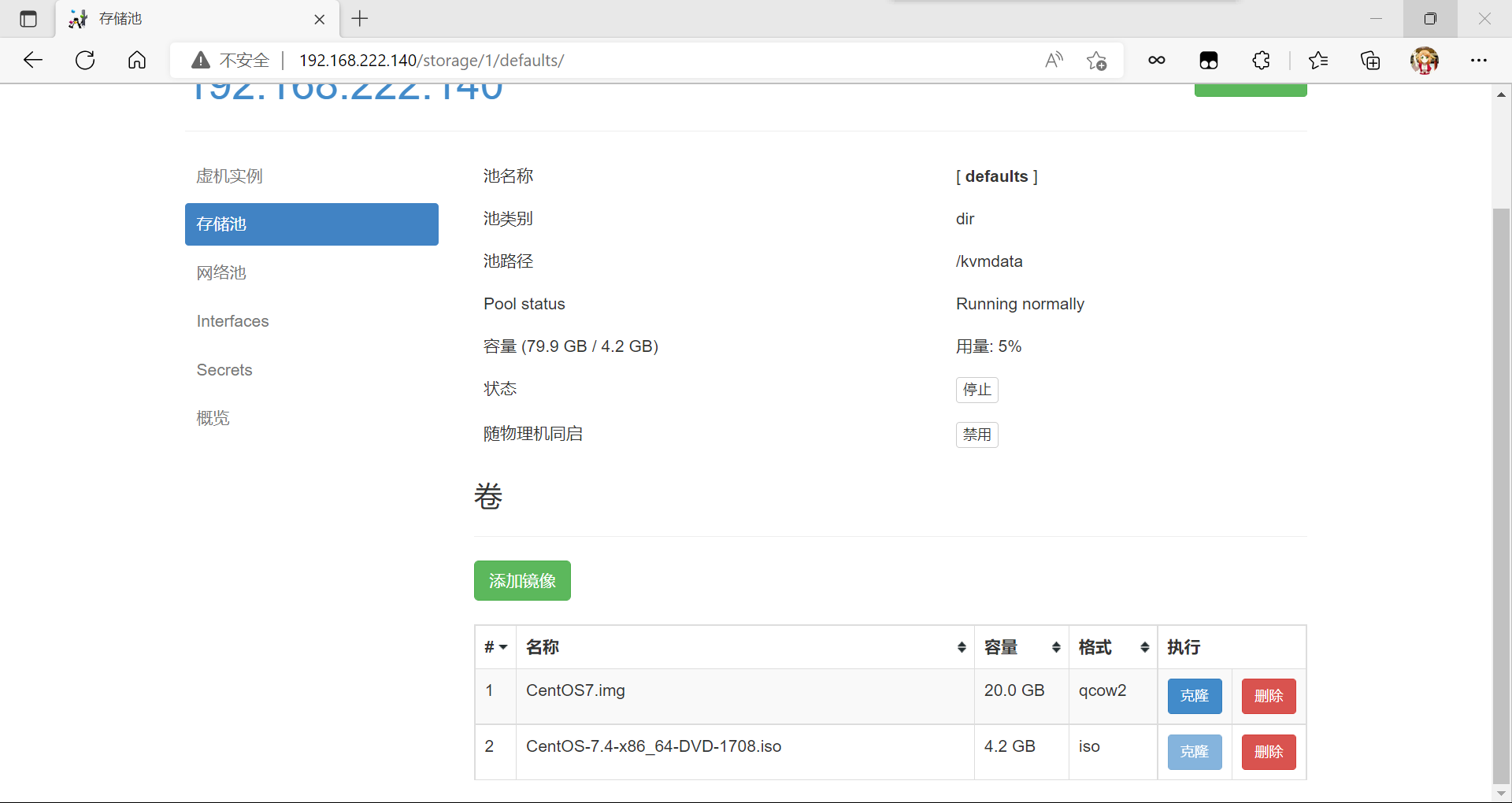
添加网络
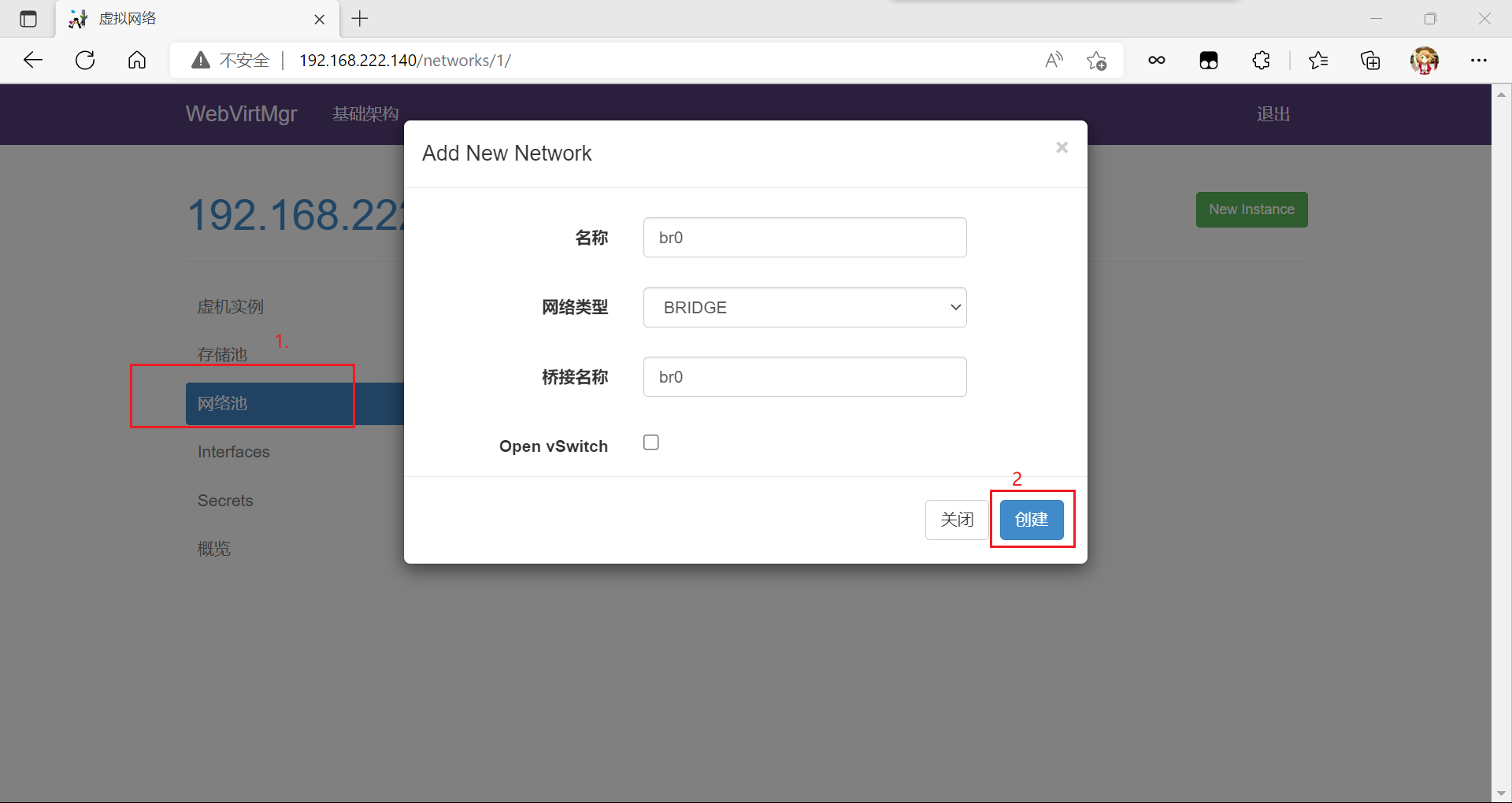
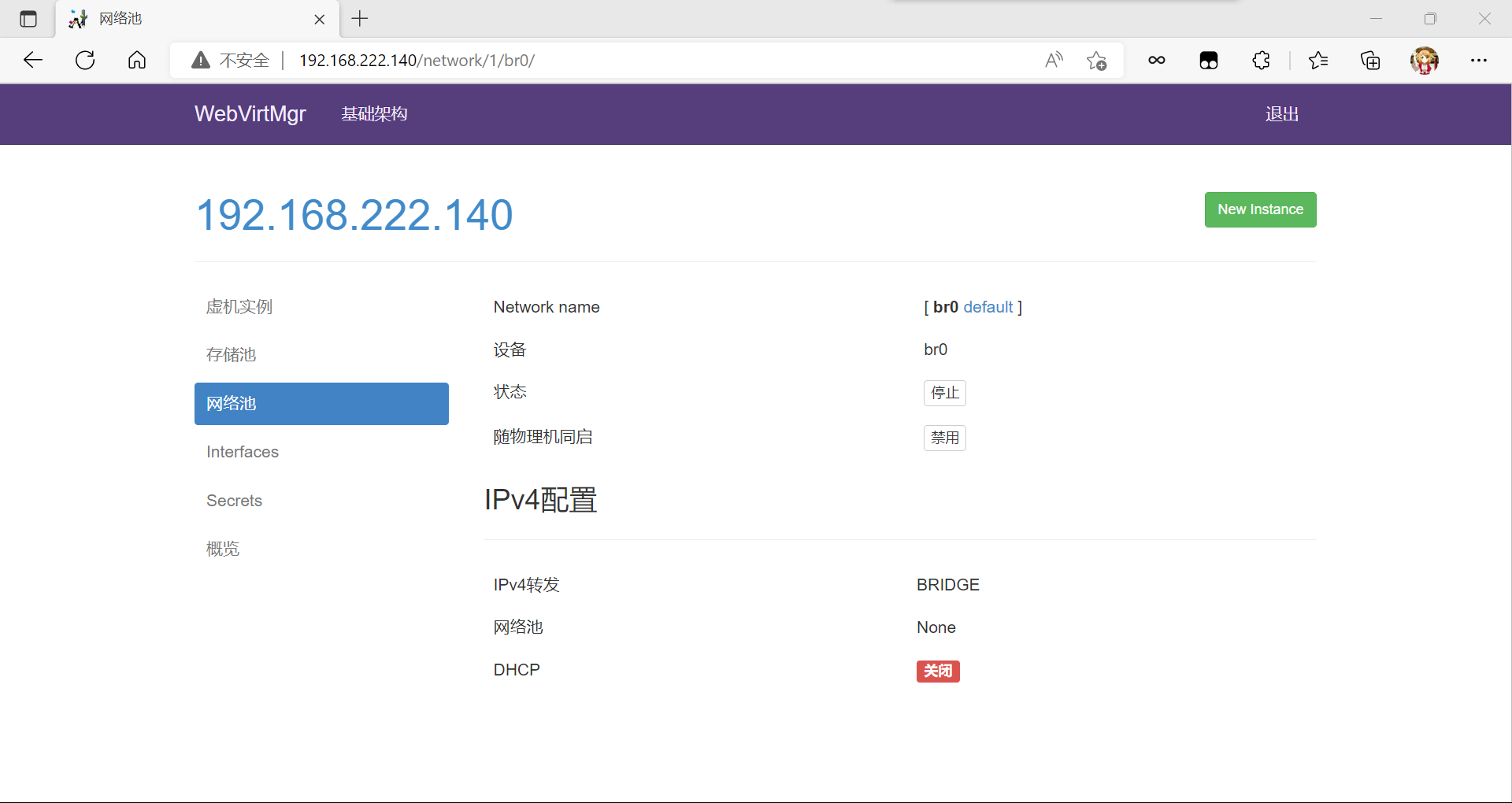
实例管理,现在去创建一个虚拟机
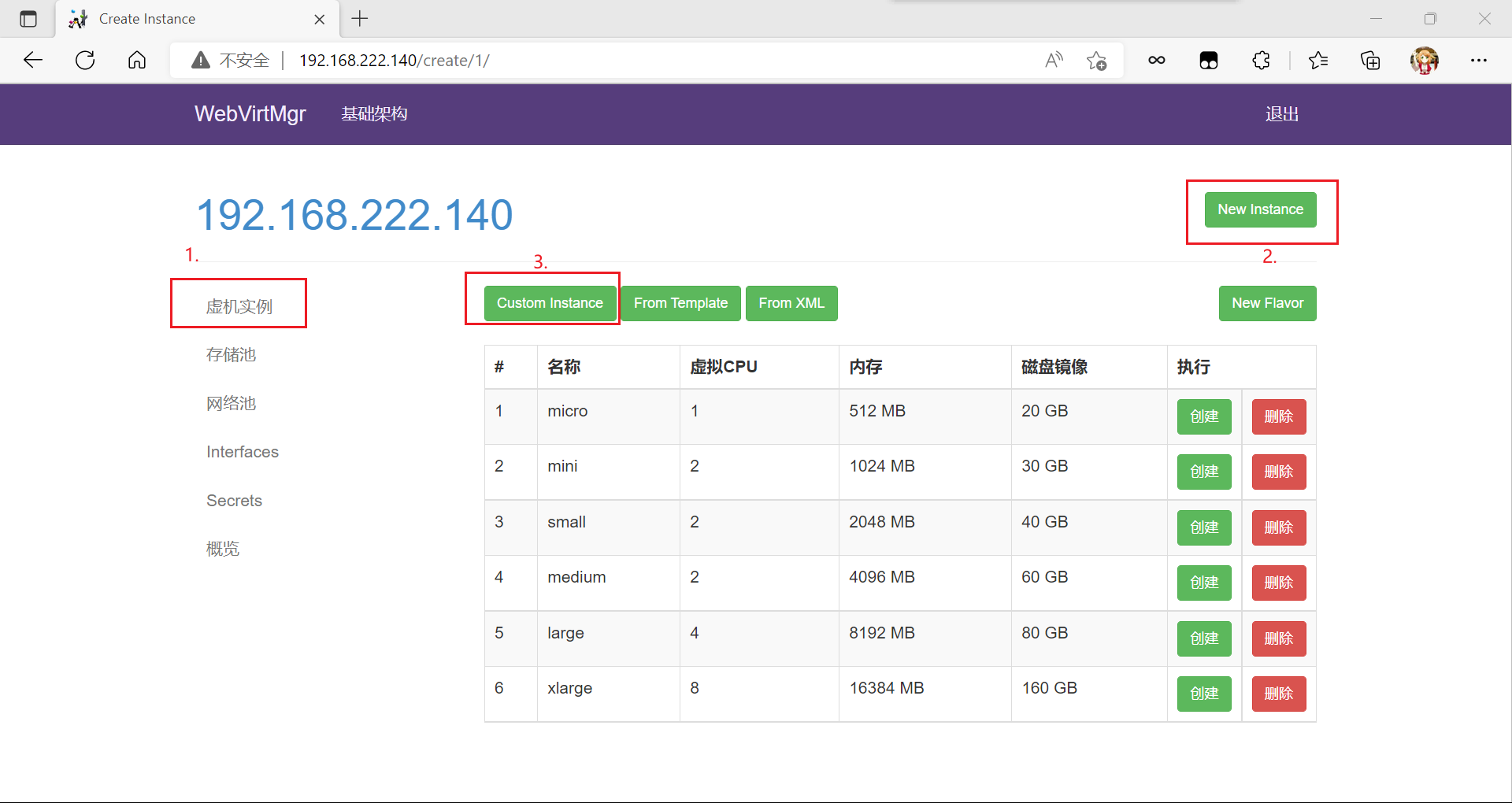
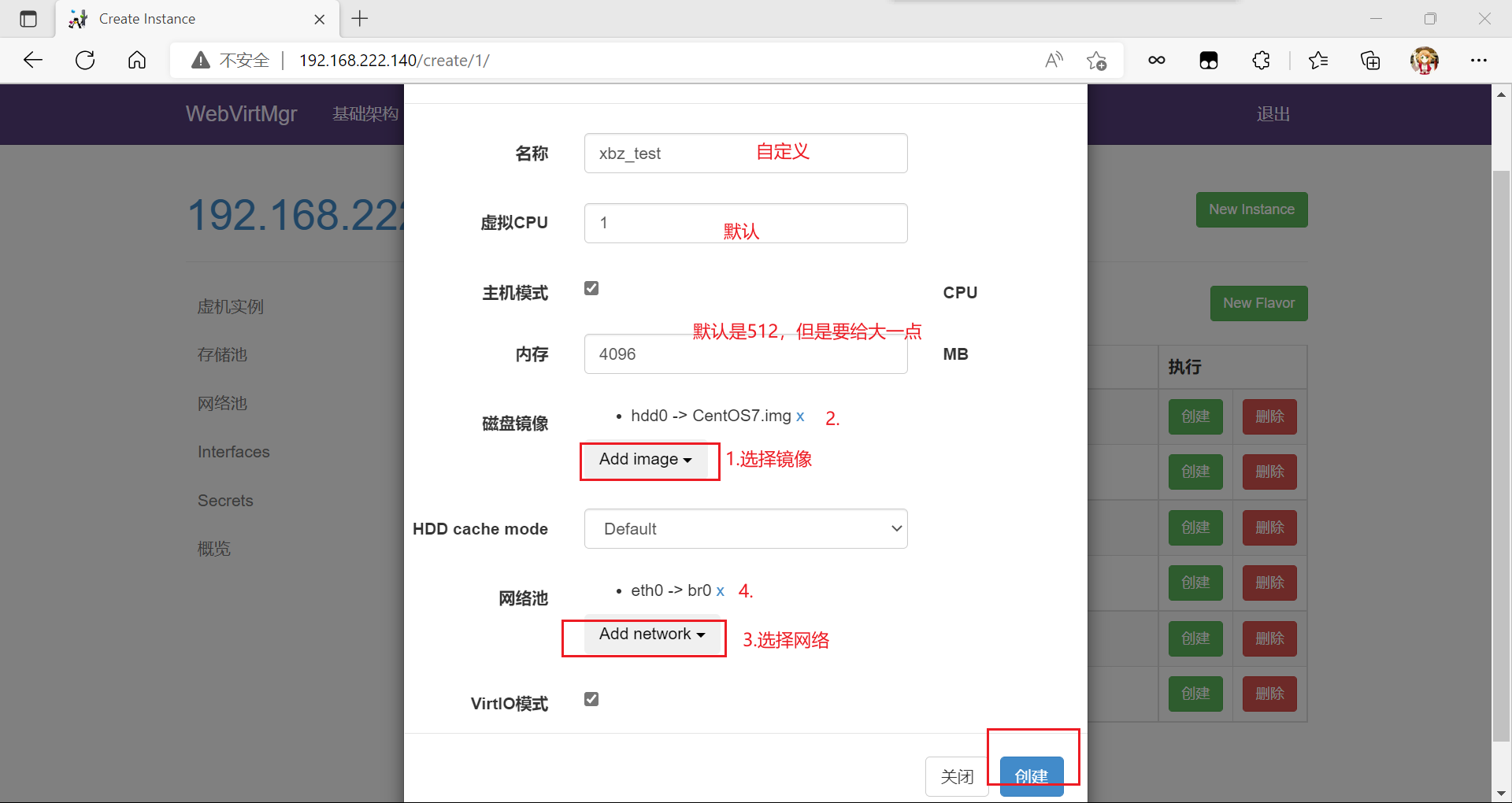
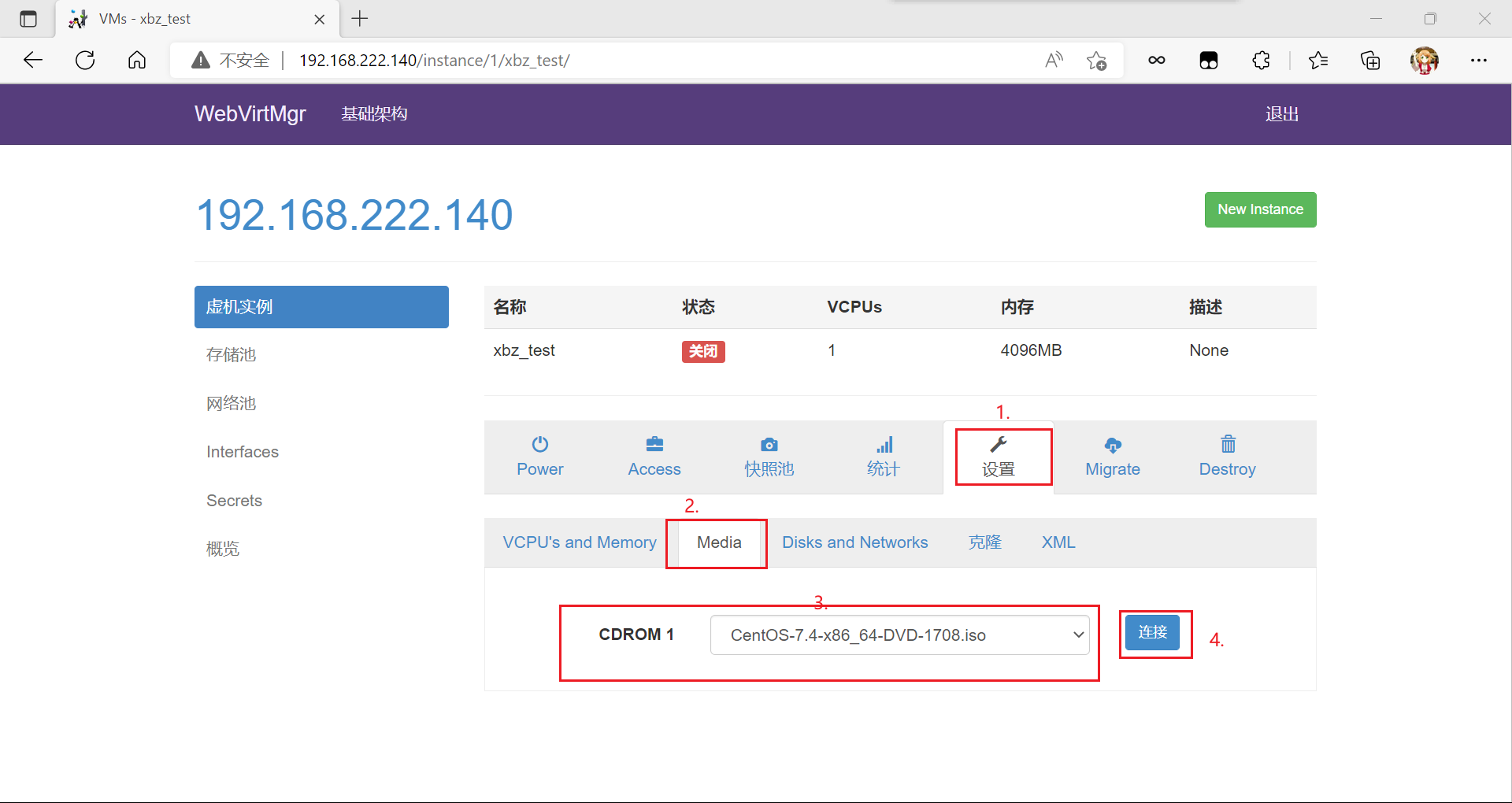
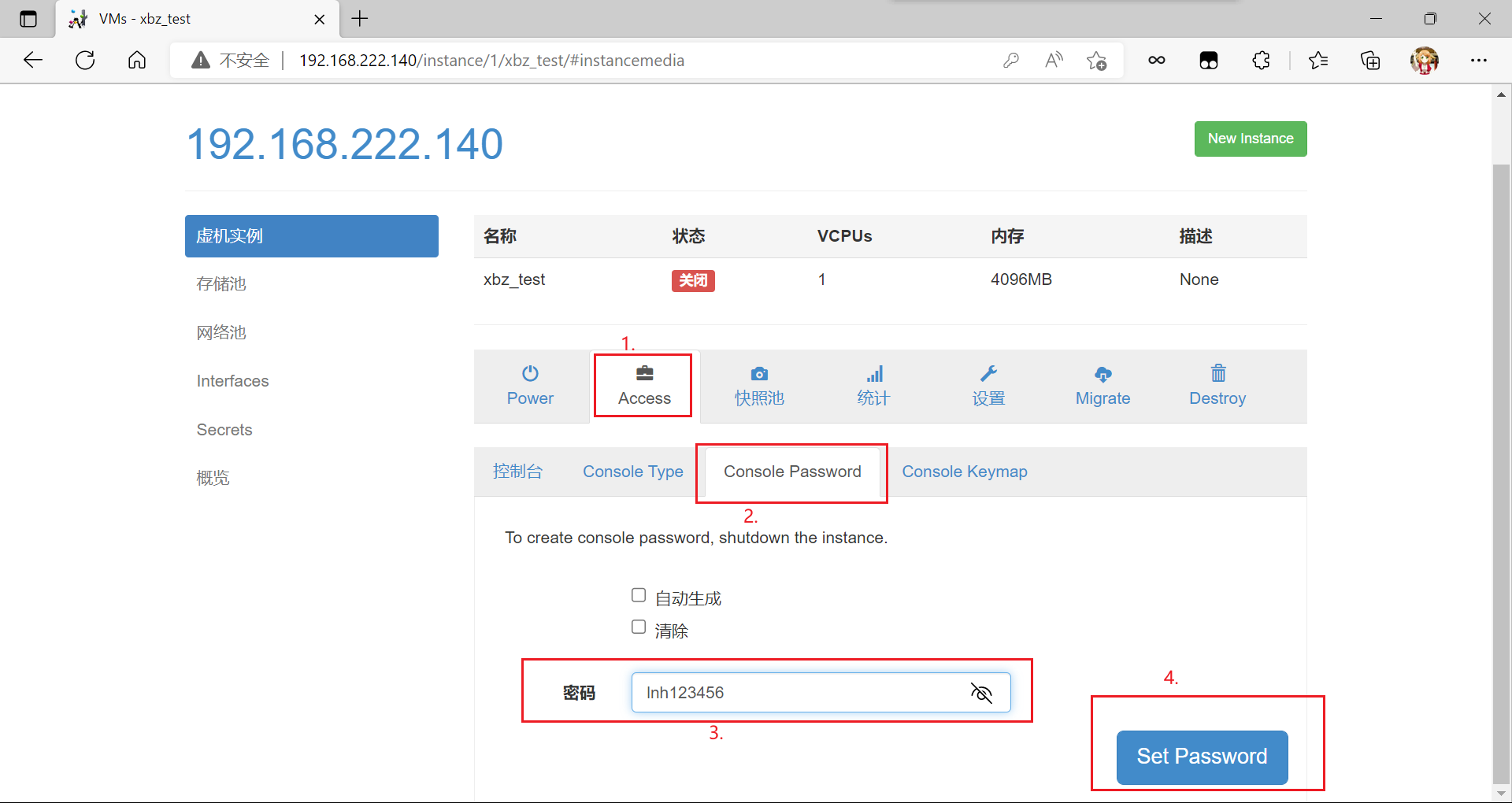
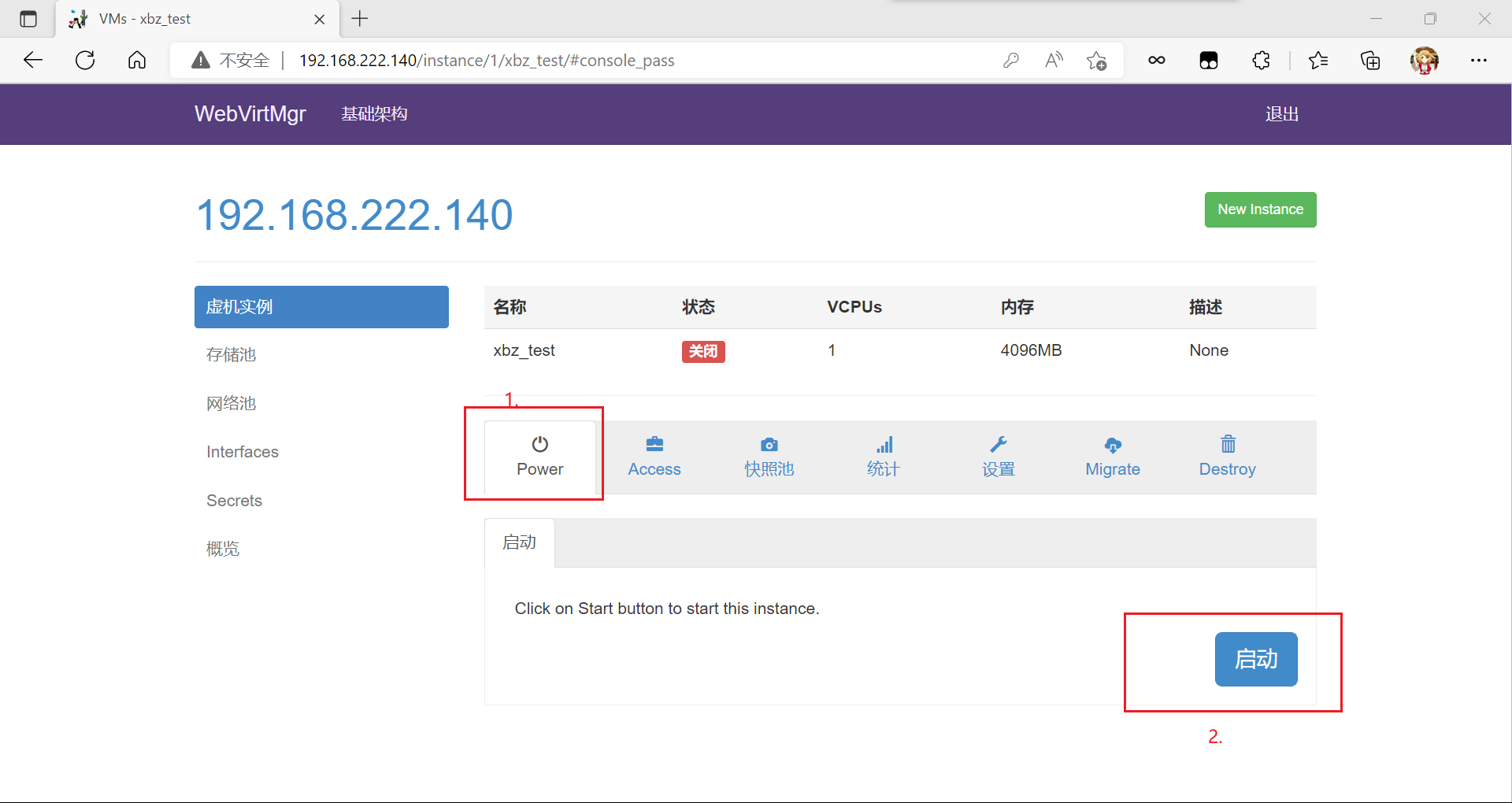
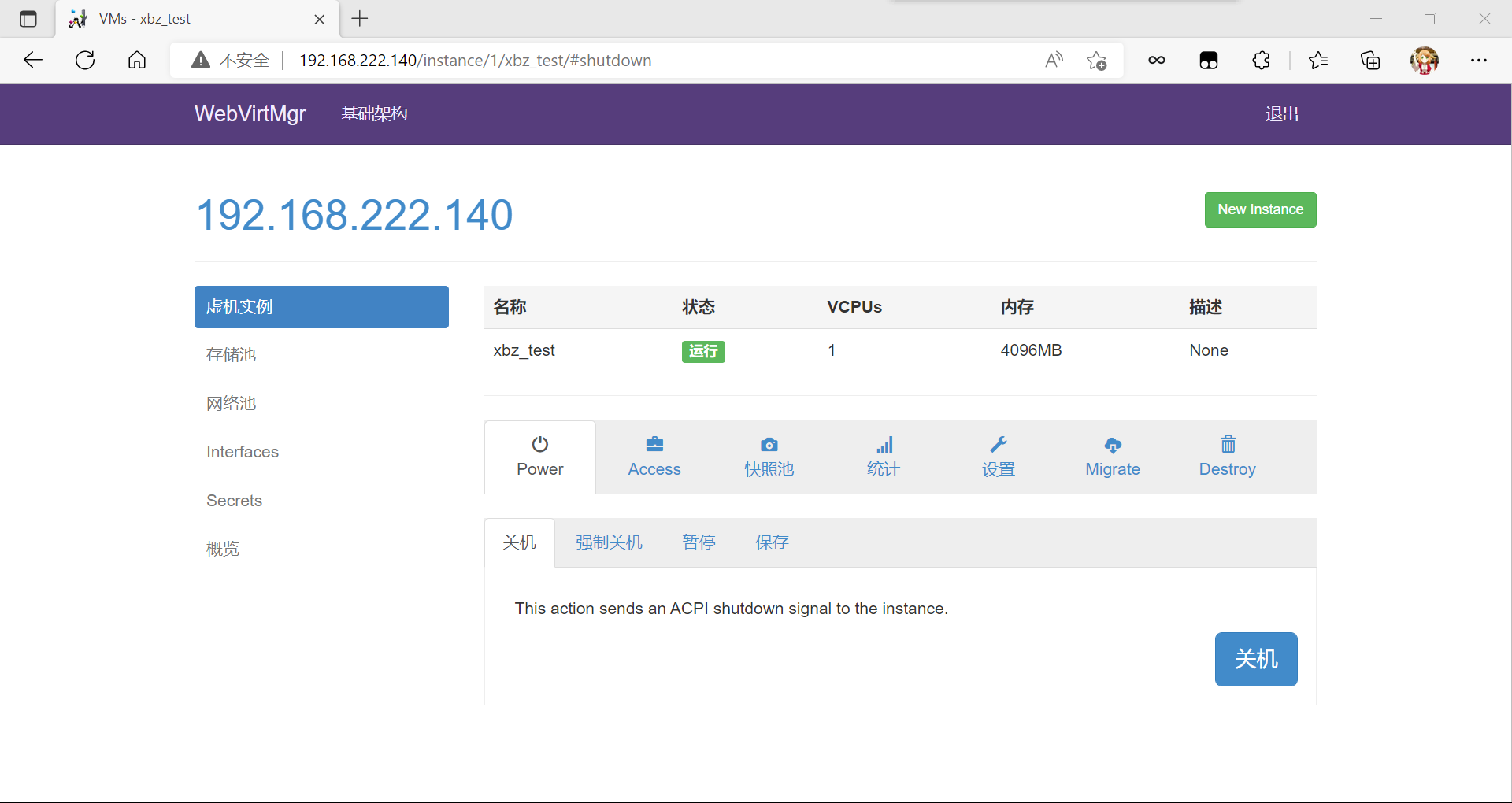
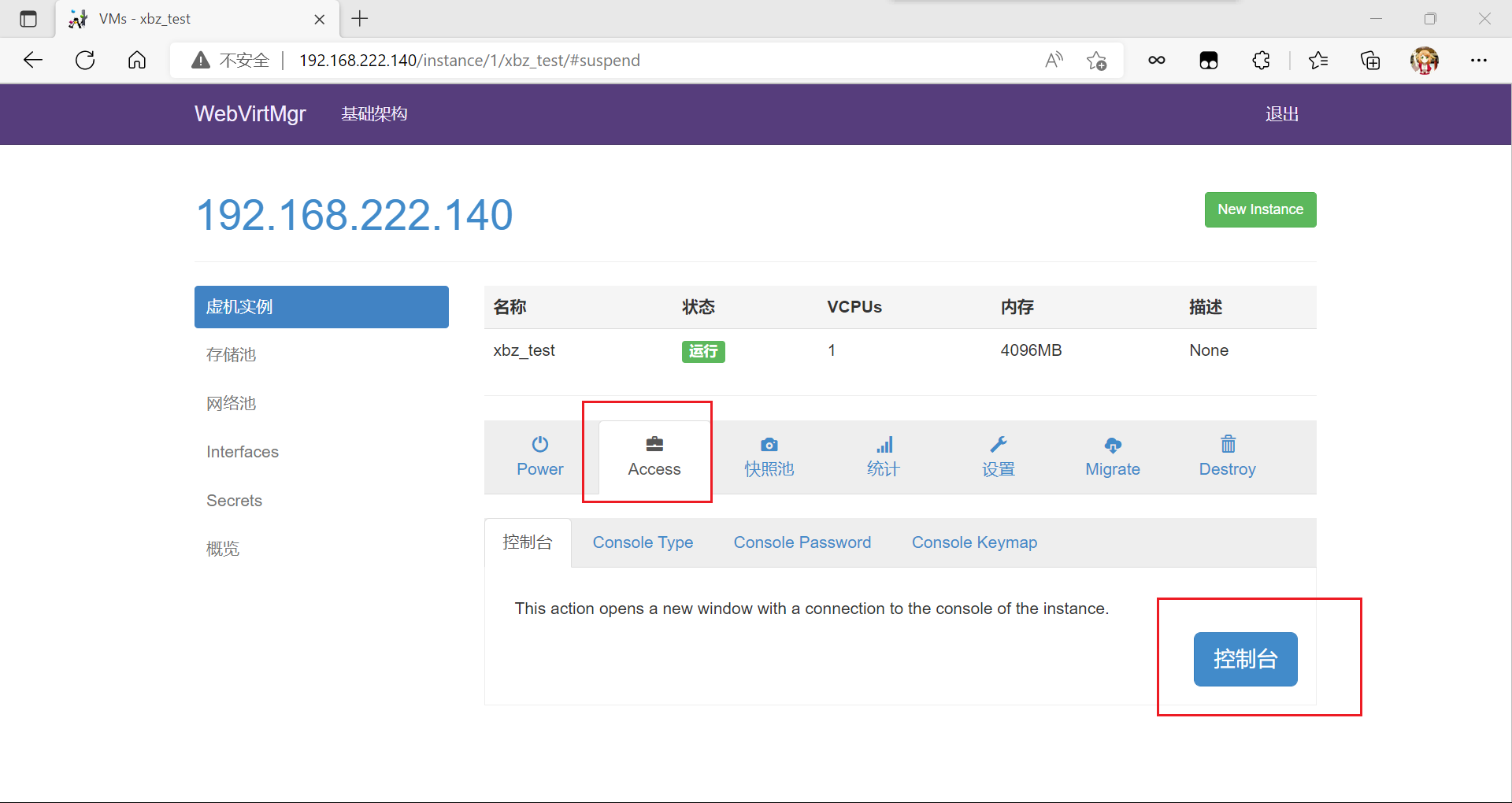
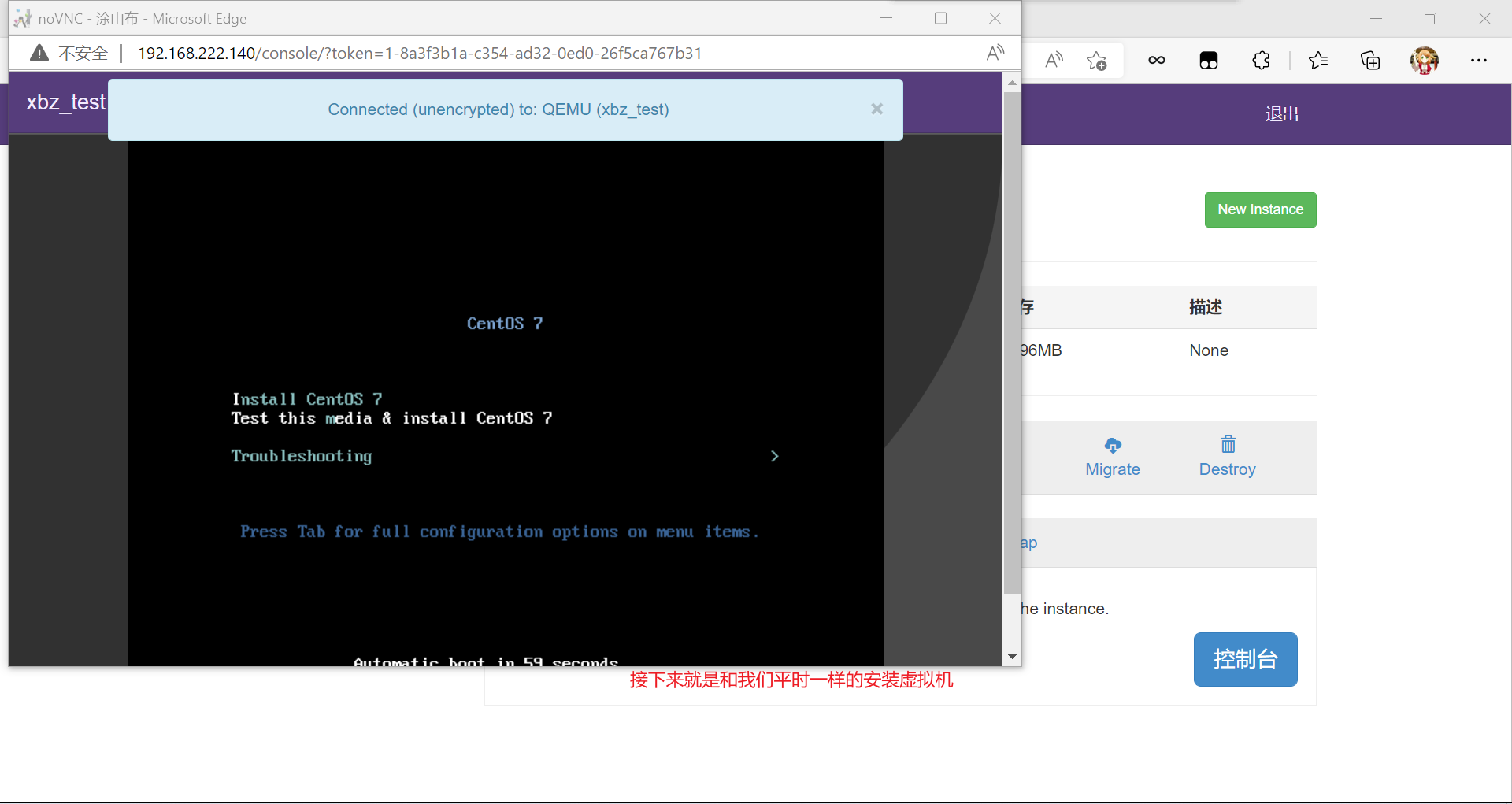
报错解决
报错: fatal: unable to access 'http://github.com/retspen/webvirtmgr.git/': Failed connect to github.com:443; Connection refused fatal: unable to access 'http://github.com/retspen/webvirtmgr.git/': TCP connection reset by peer 解决: [root@localhost src]# git config --global -l fatal: unable to read config file '/root/.gitconfig': ????????? [root@localhost src]# env|grep -i proxy 
